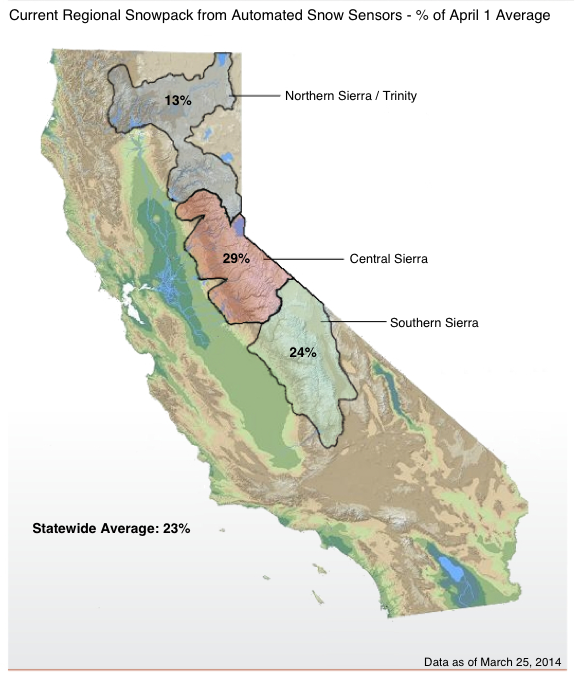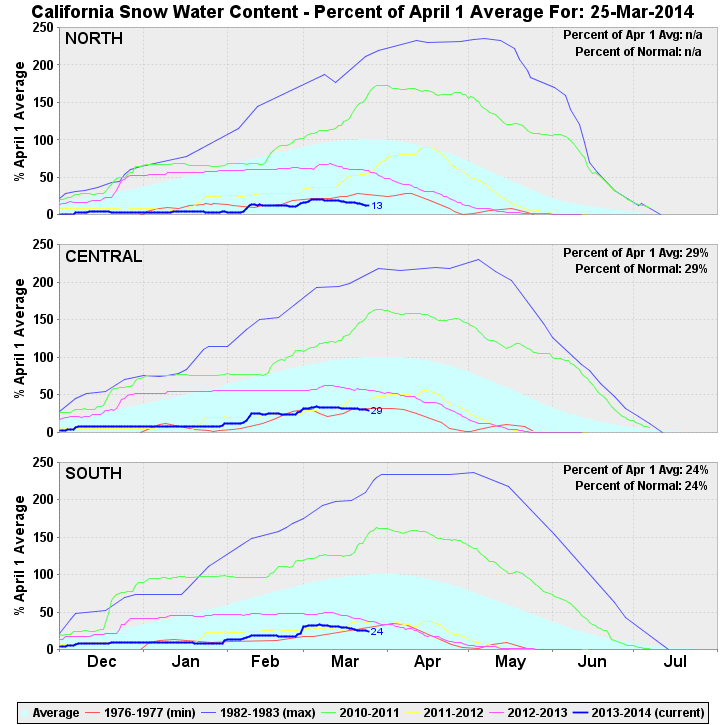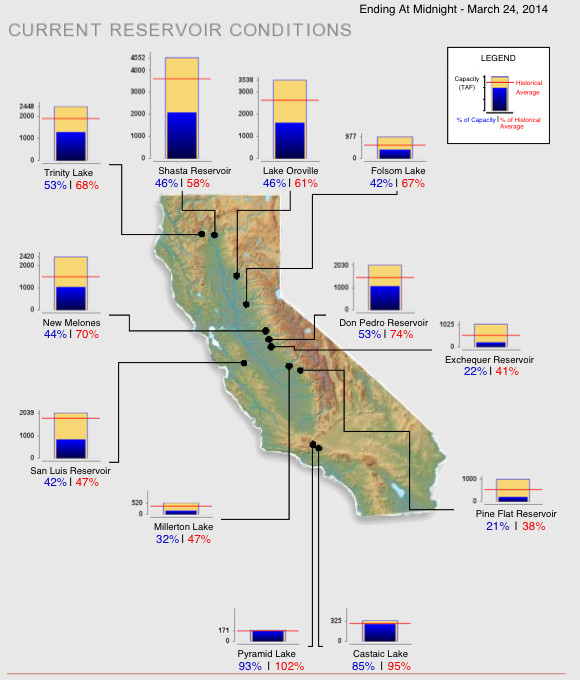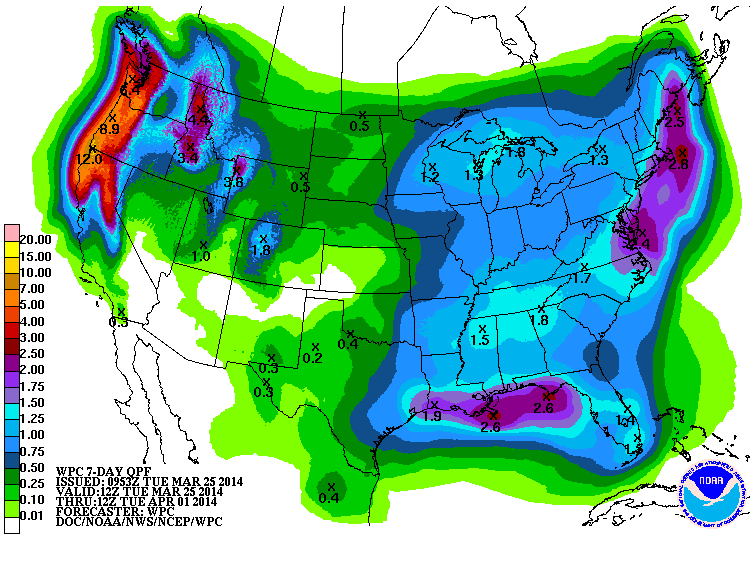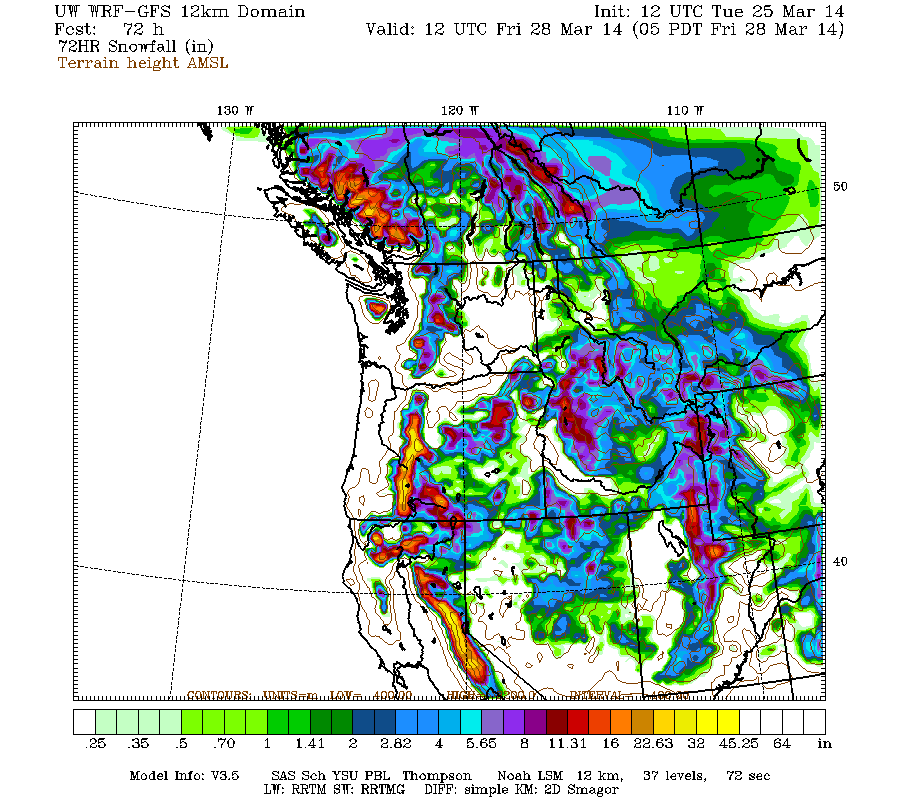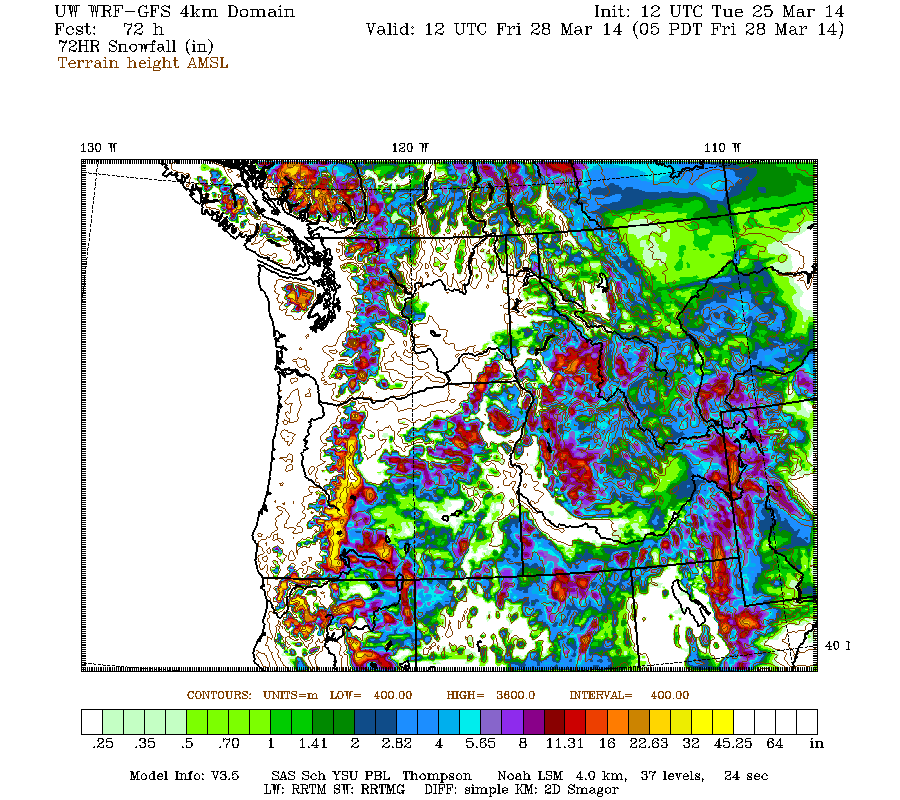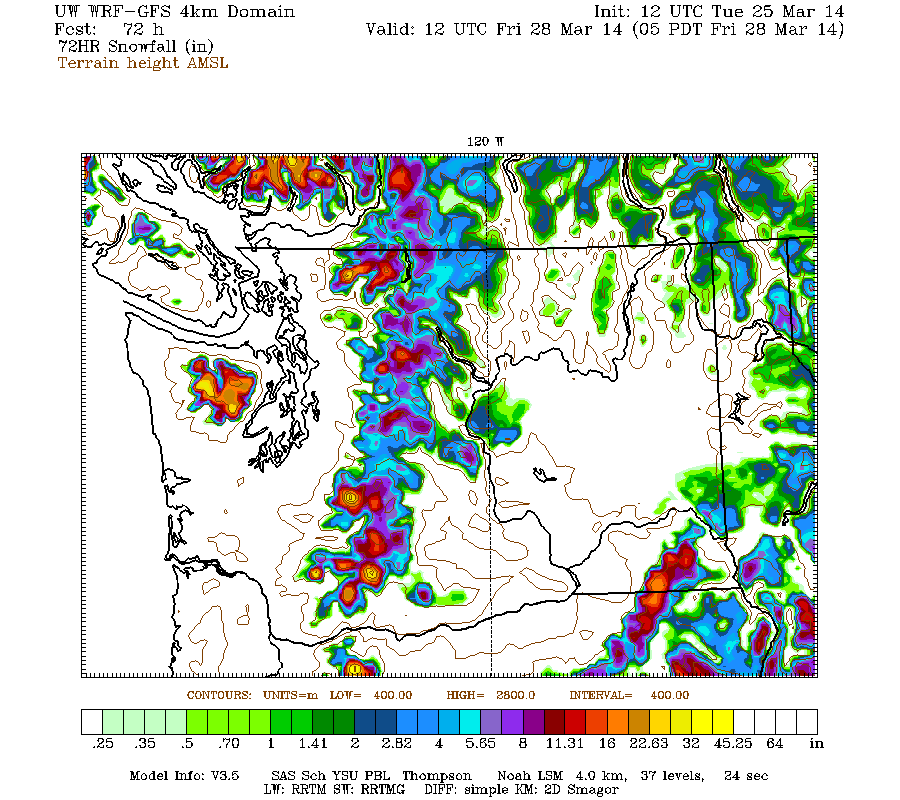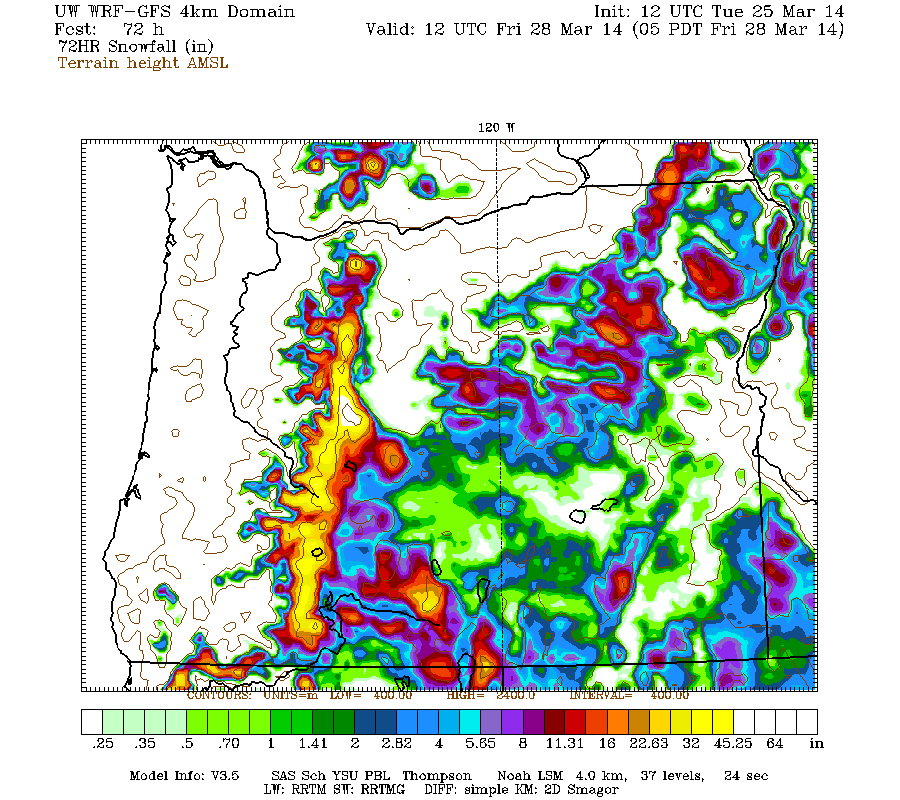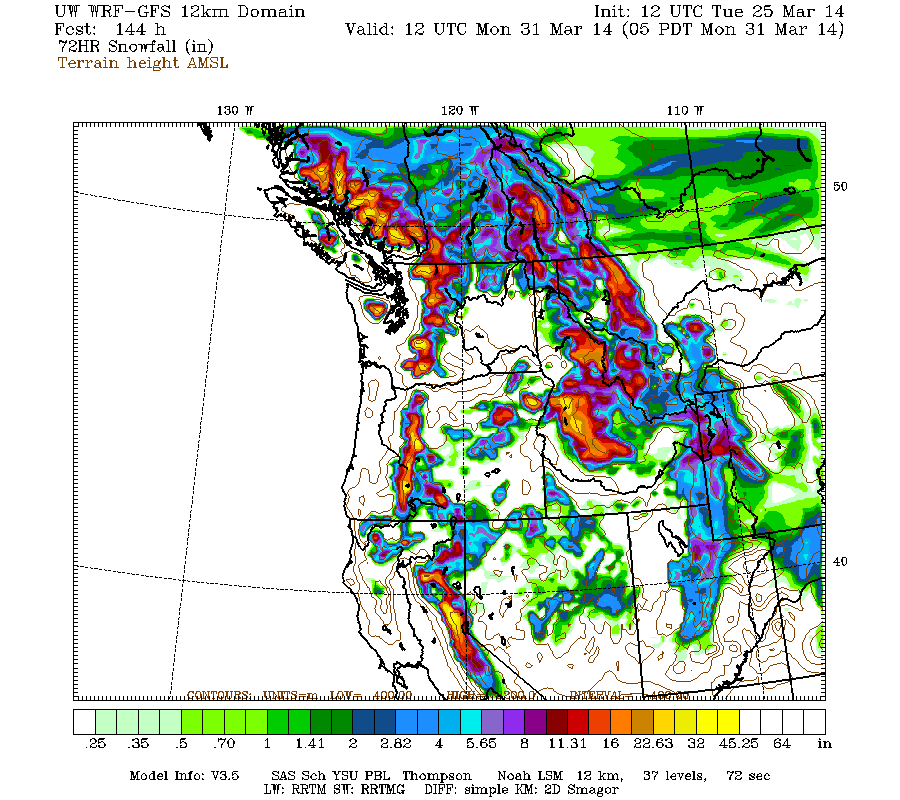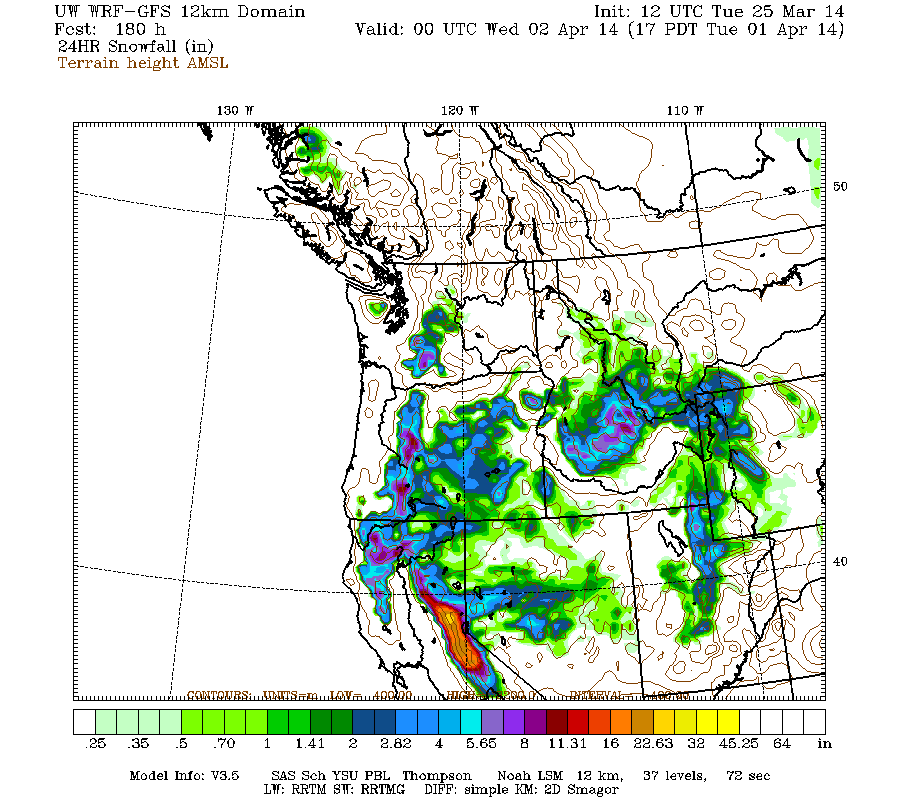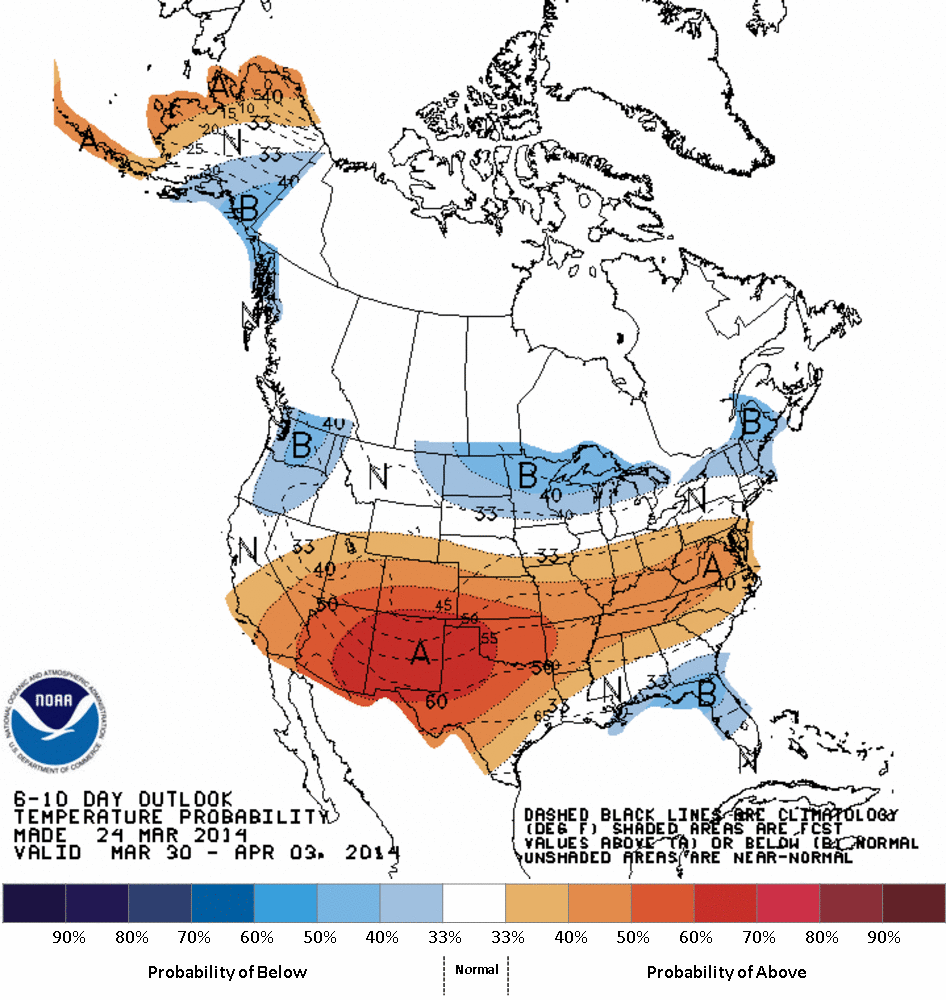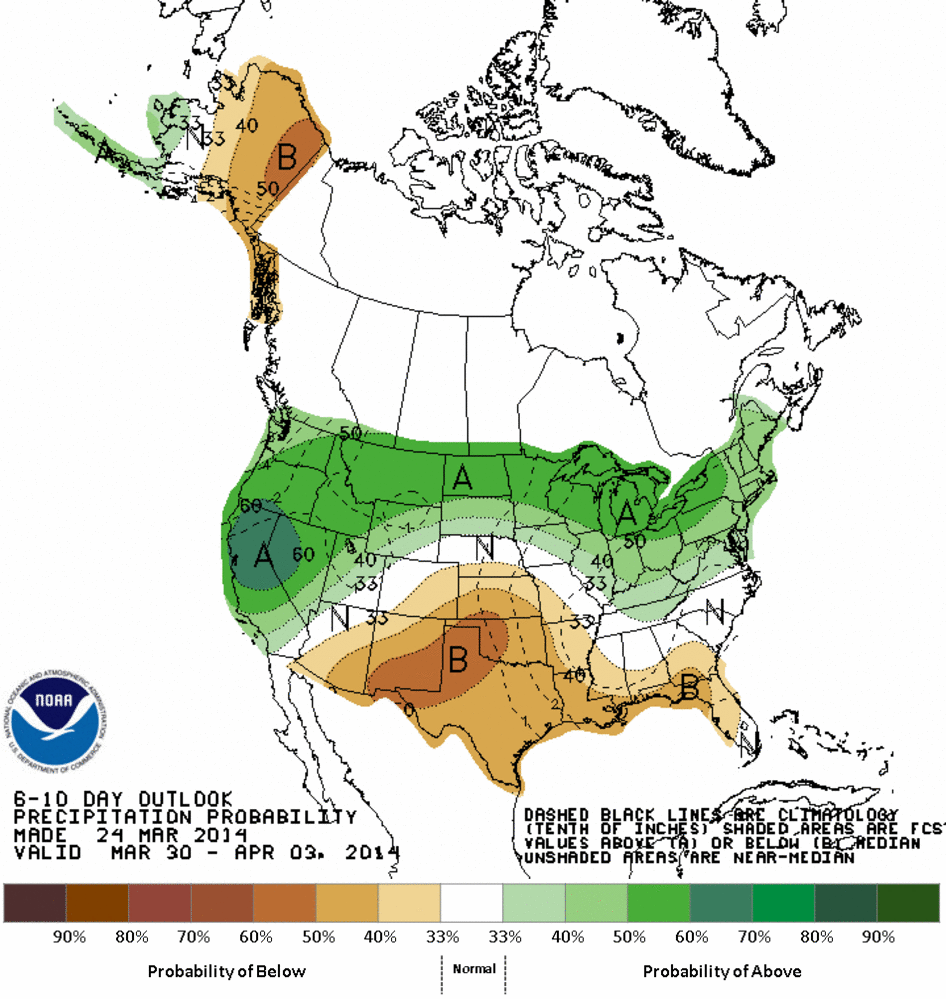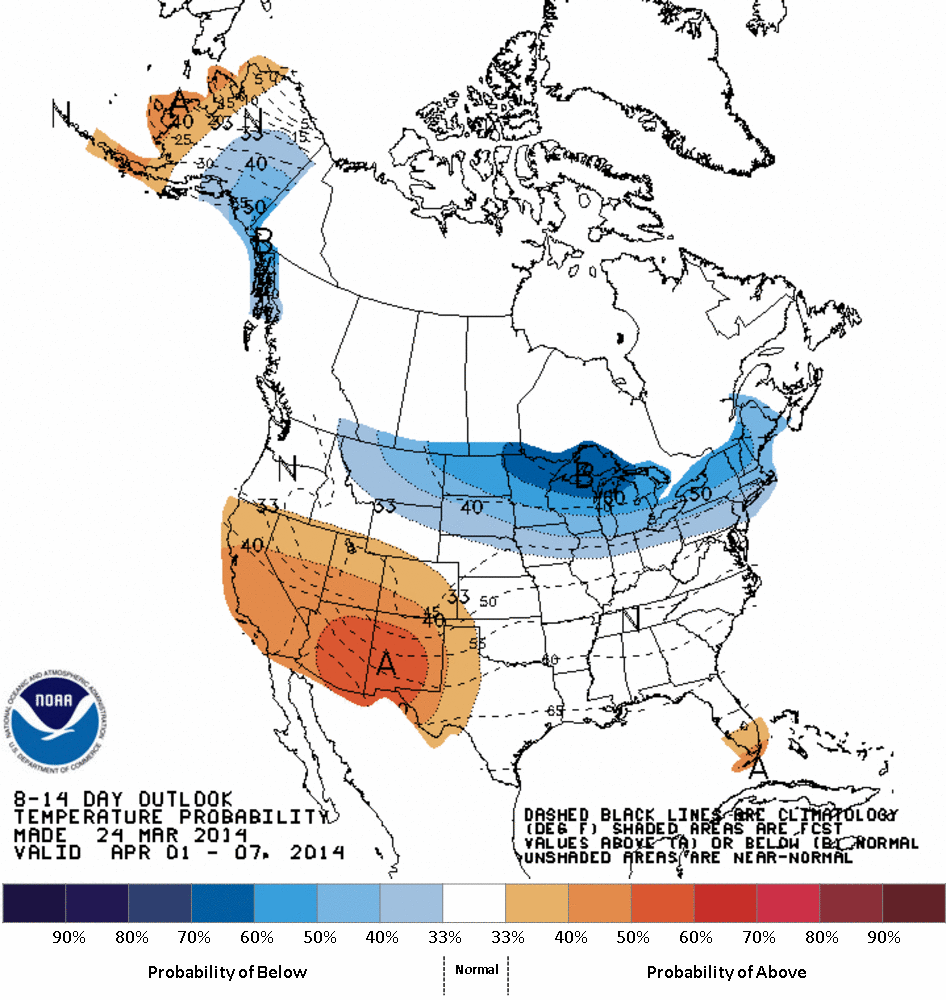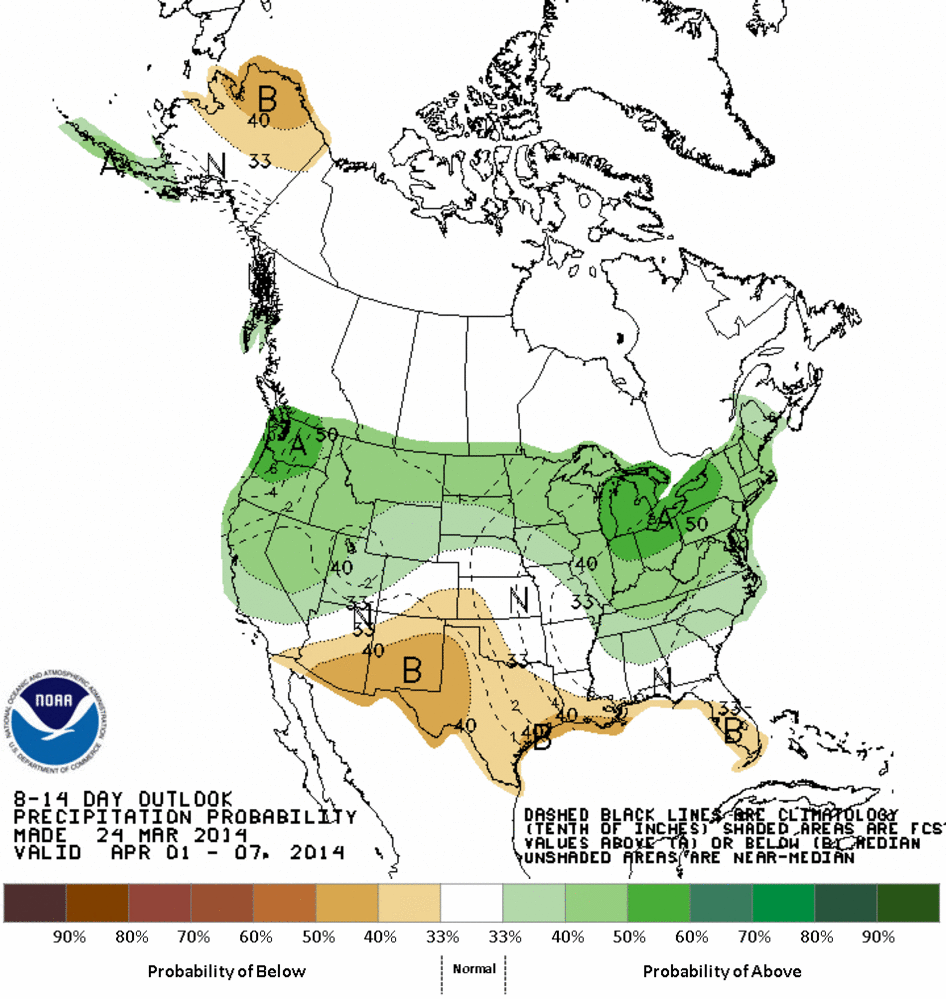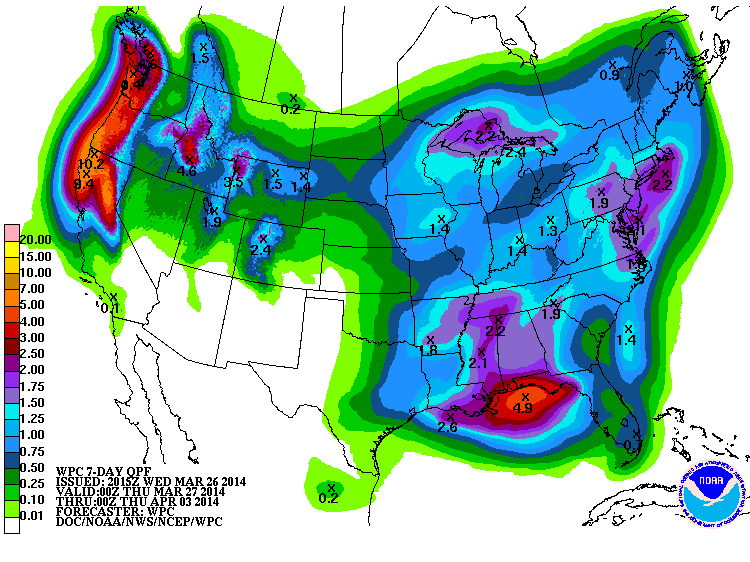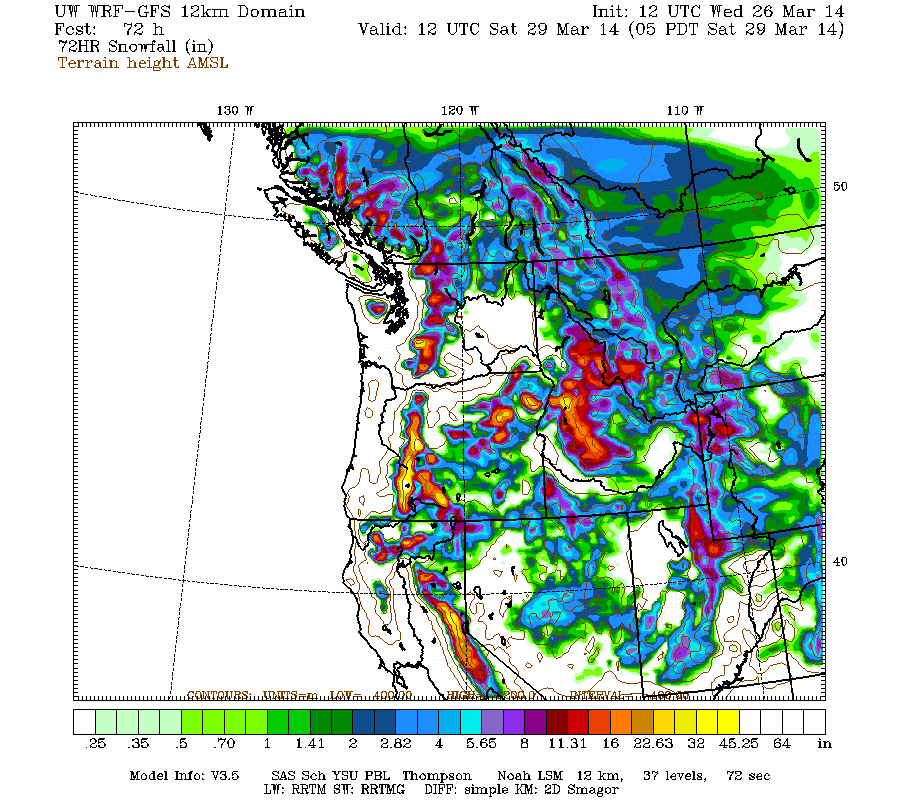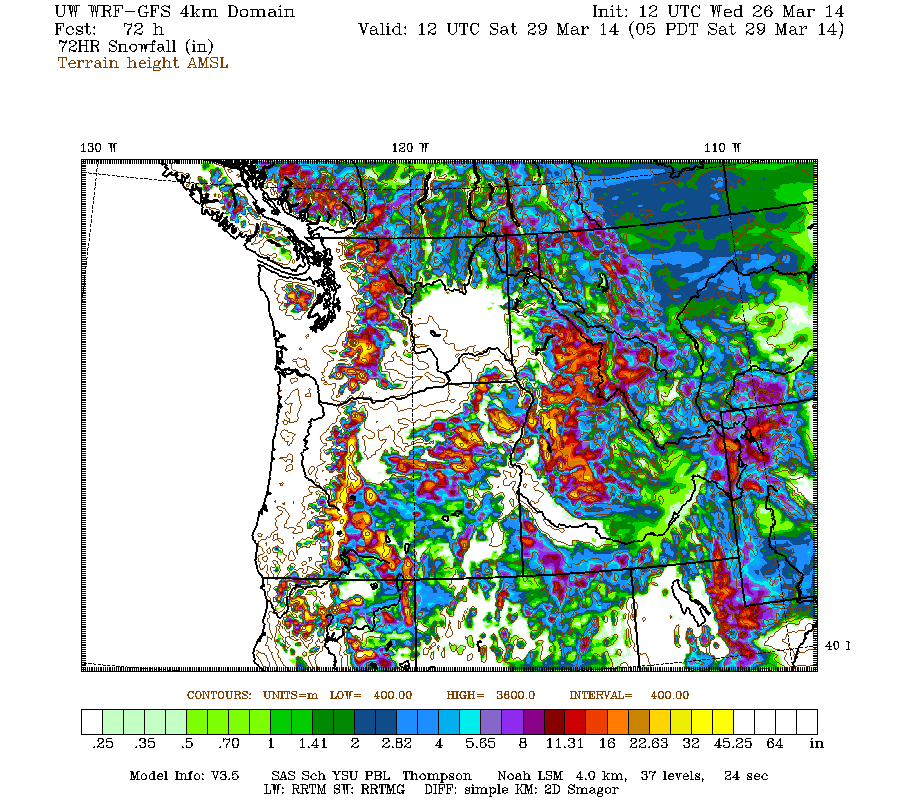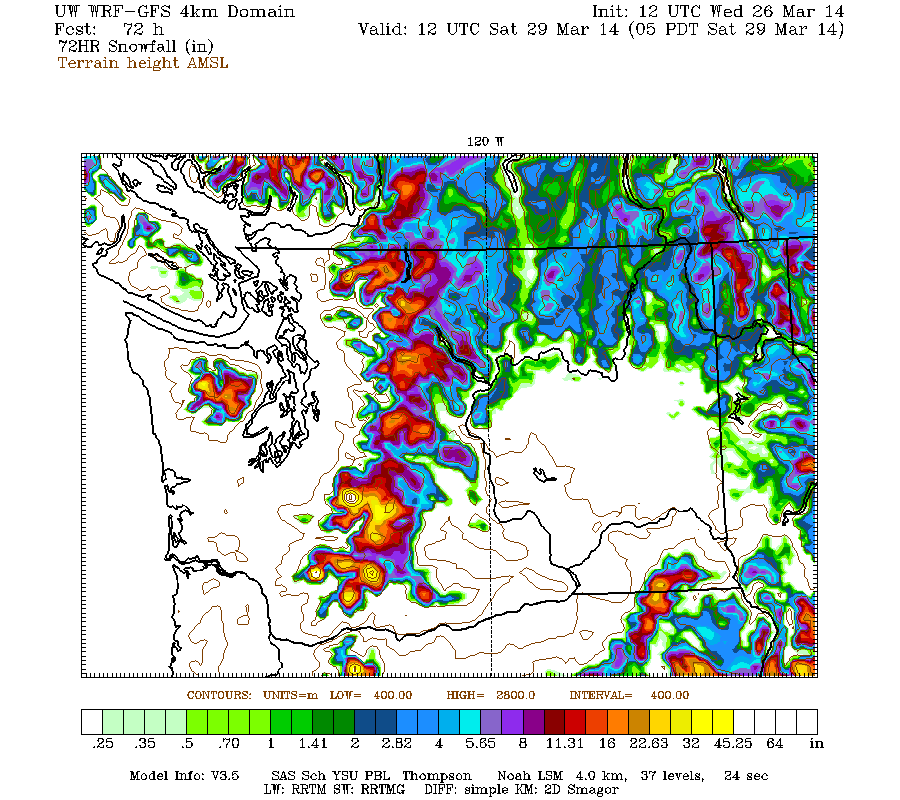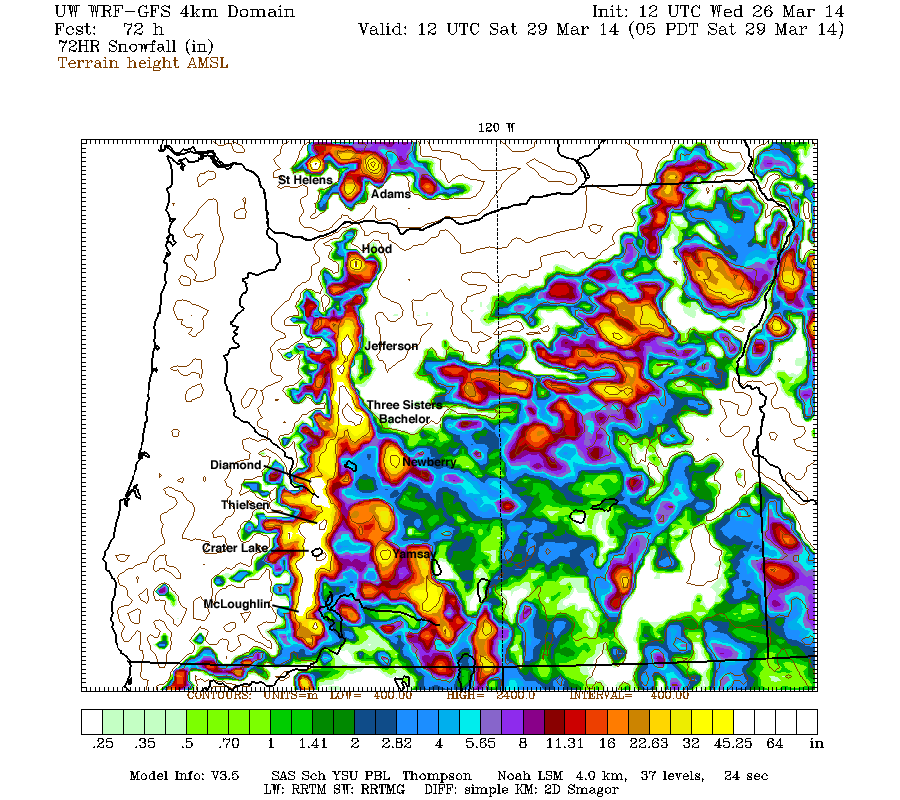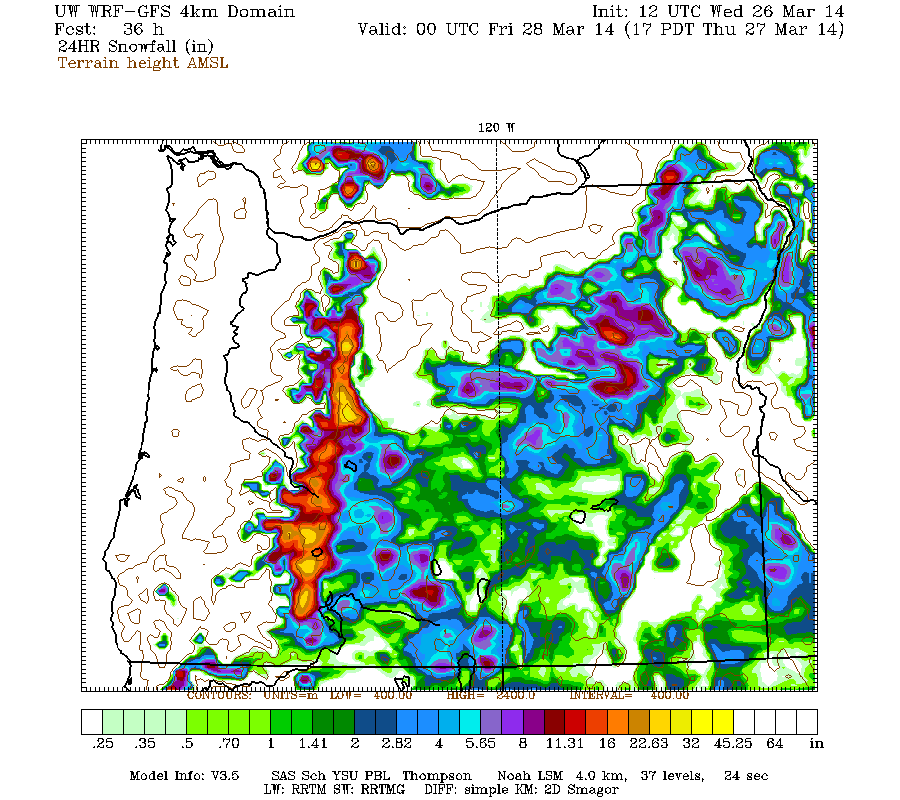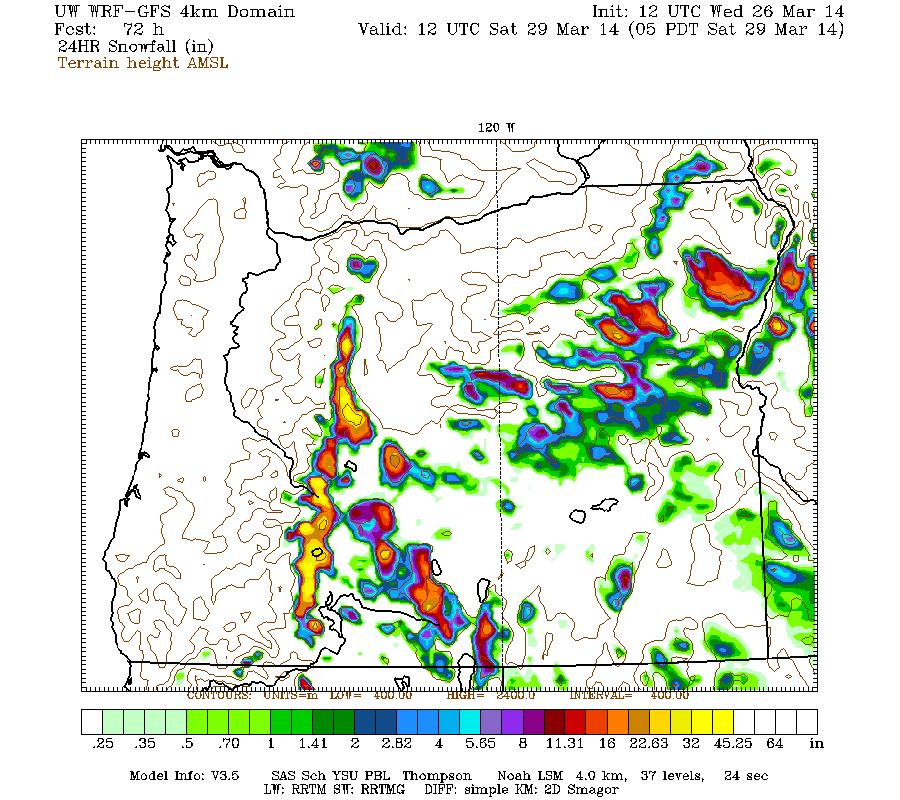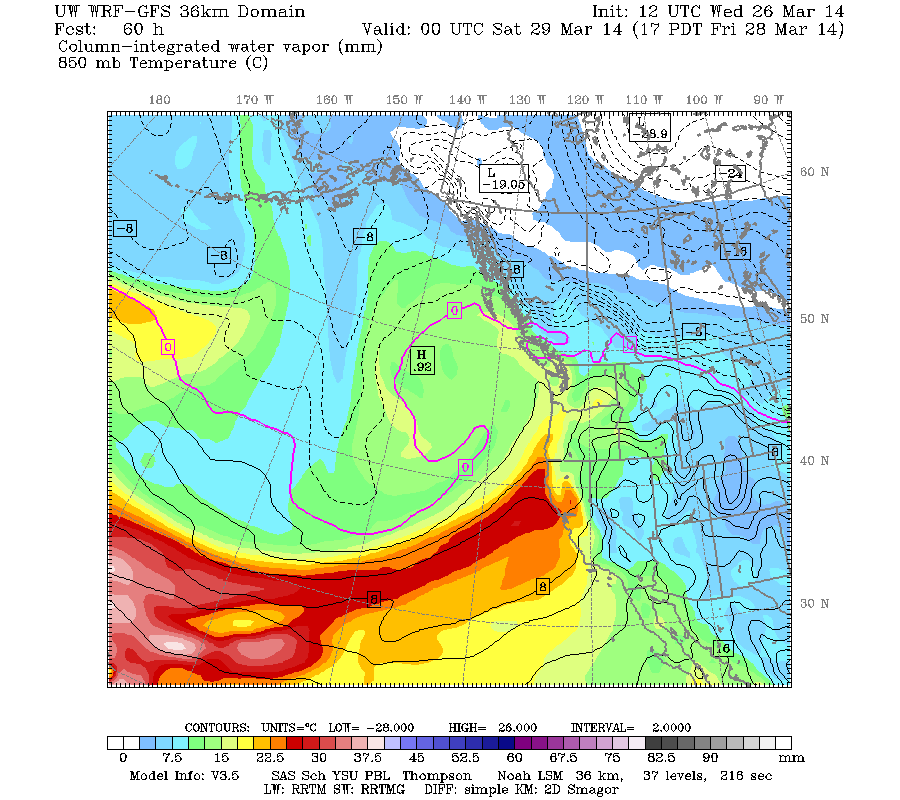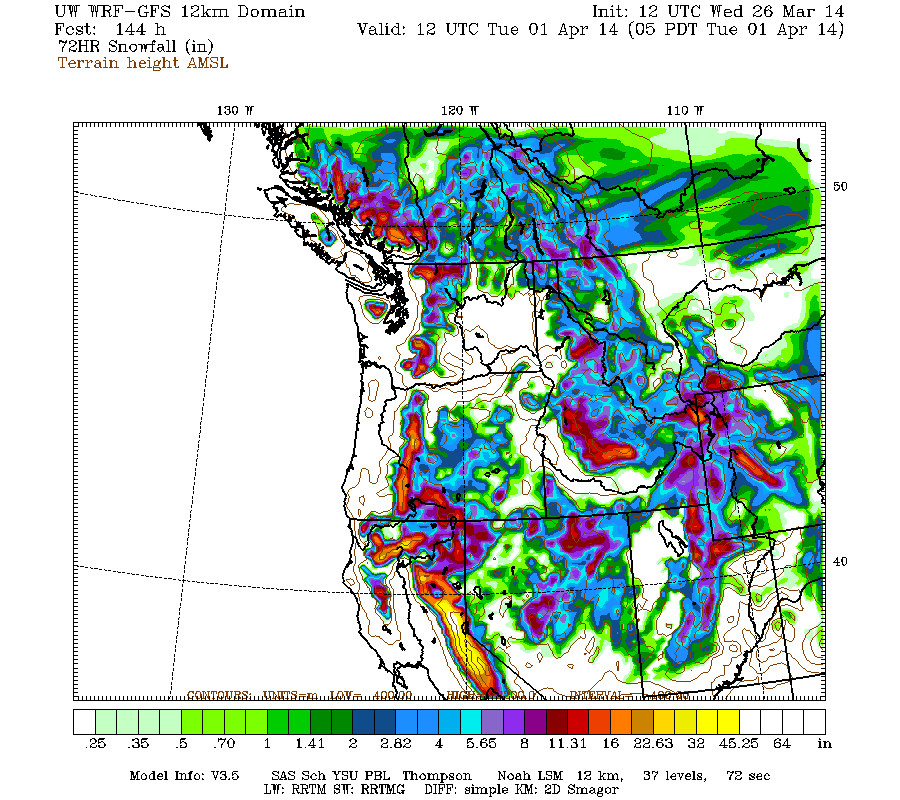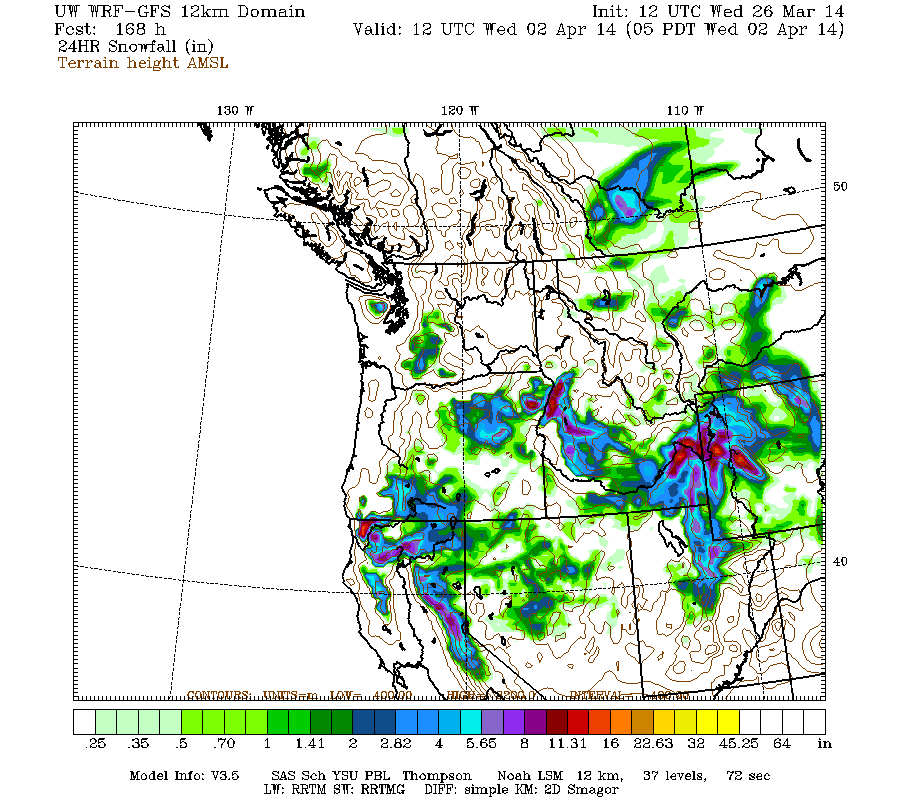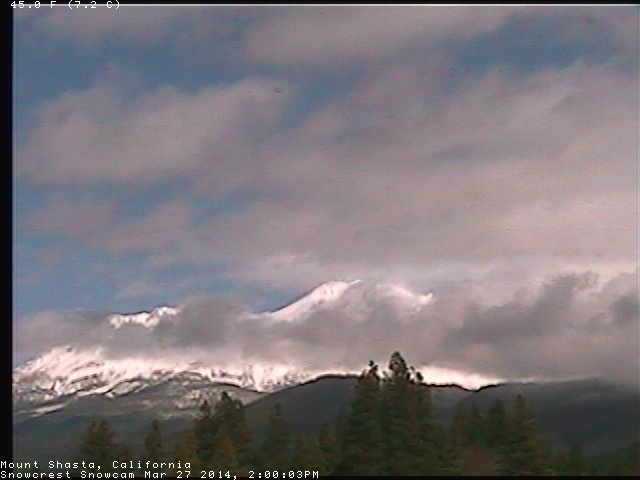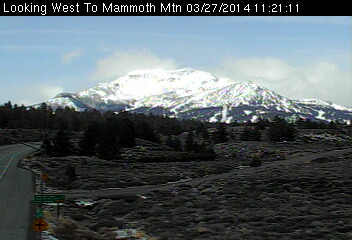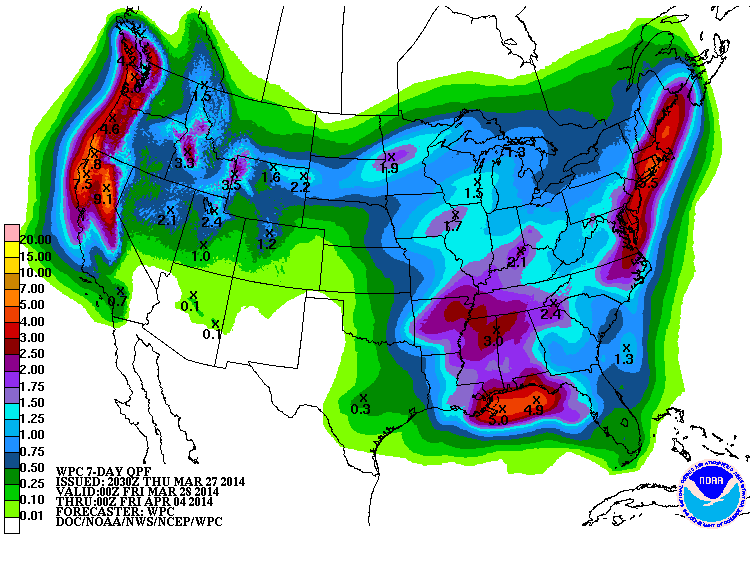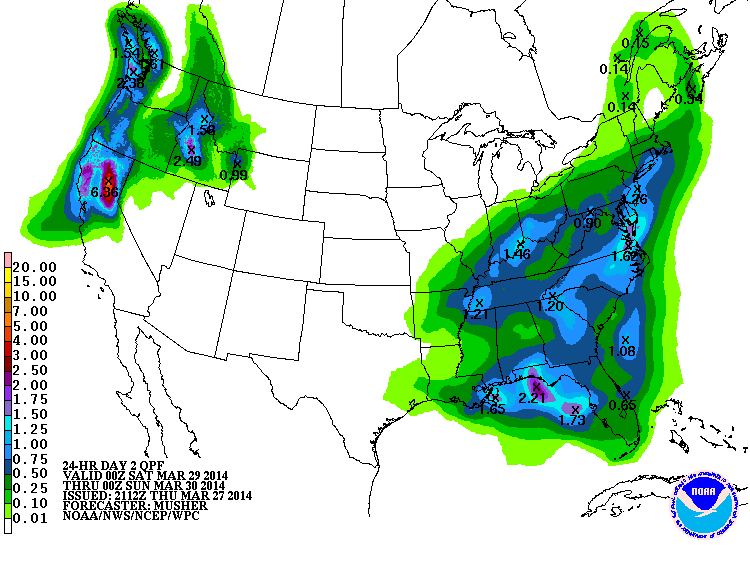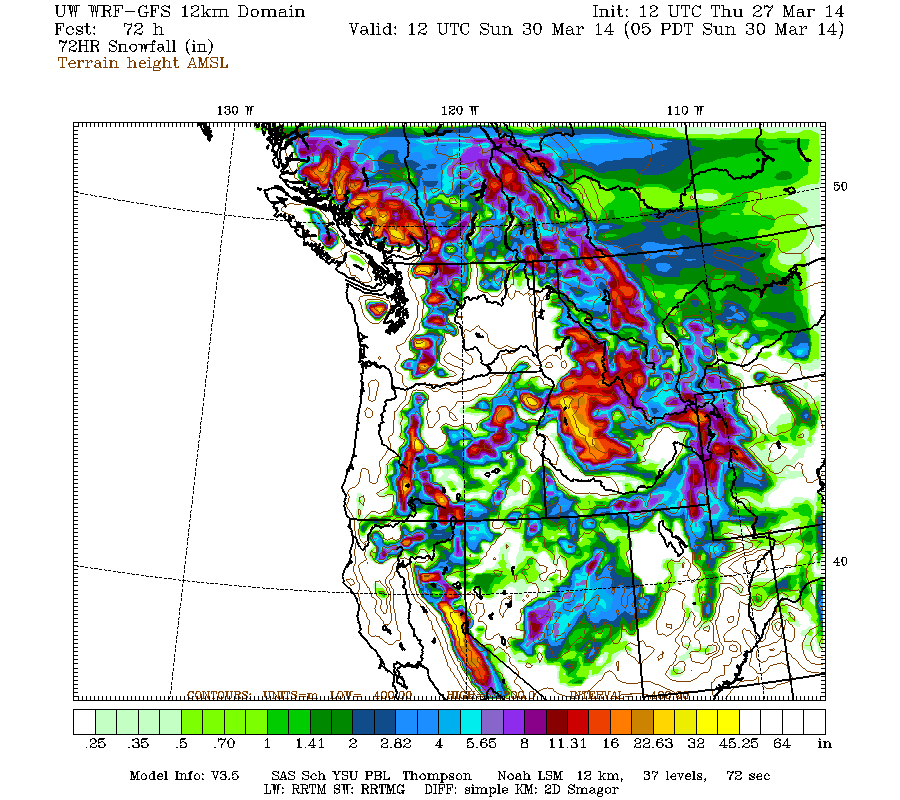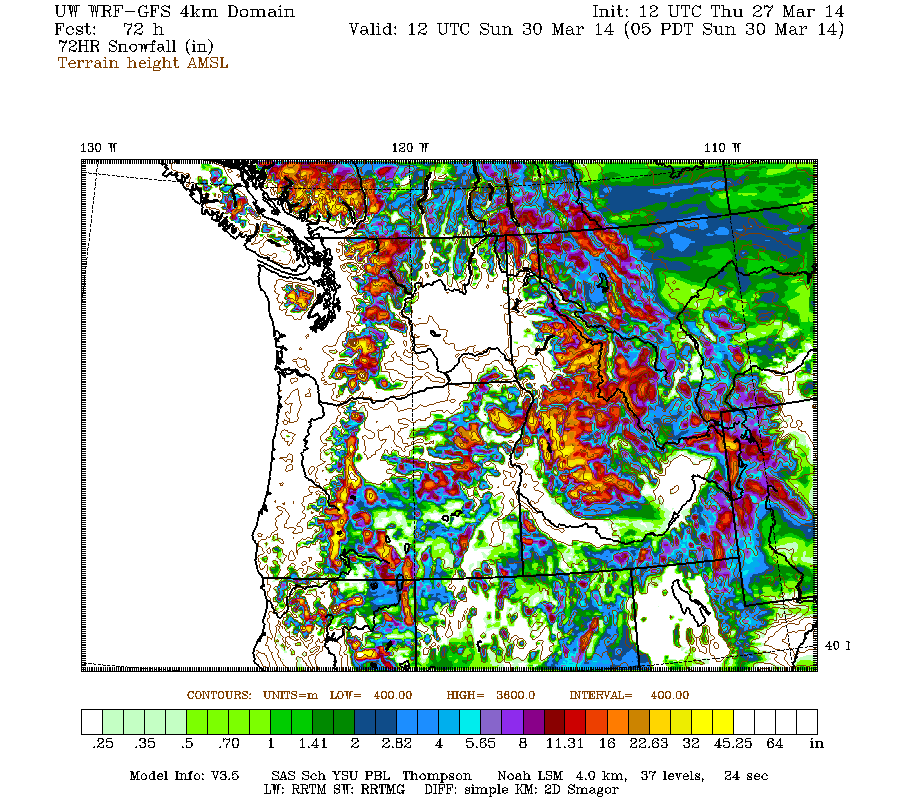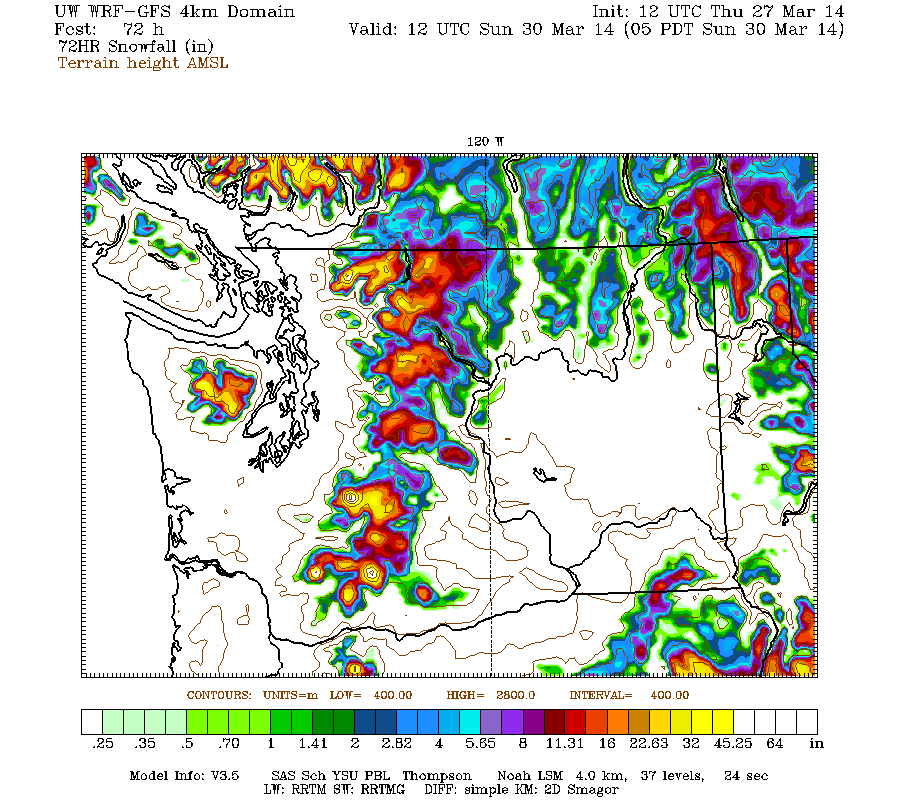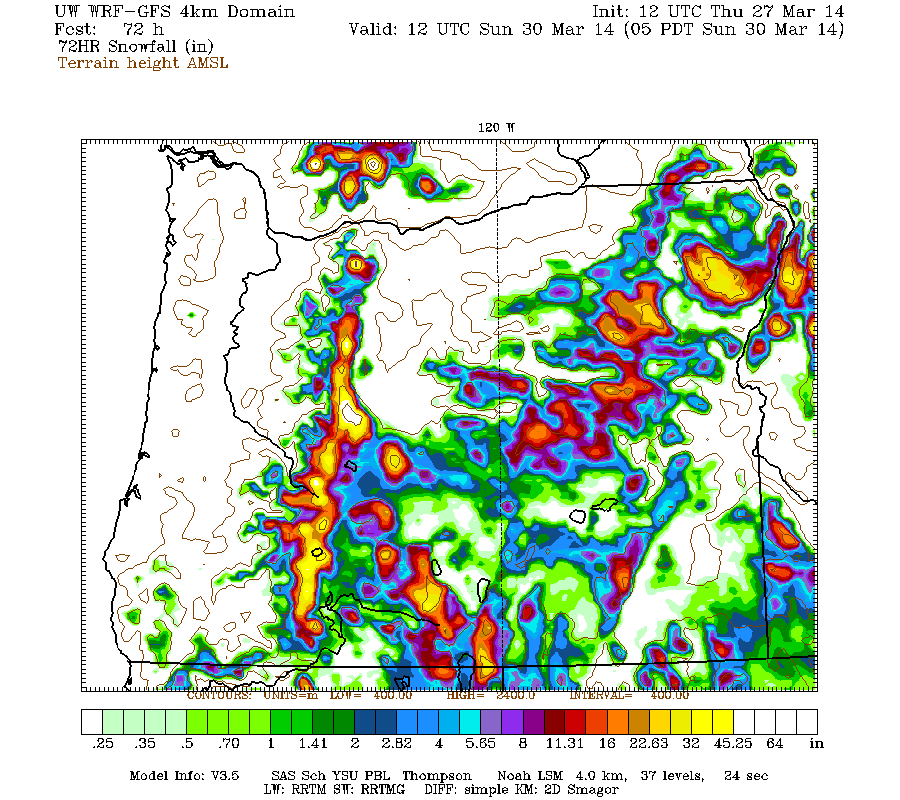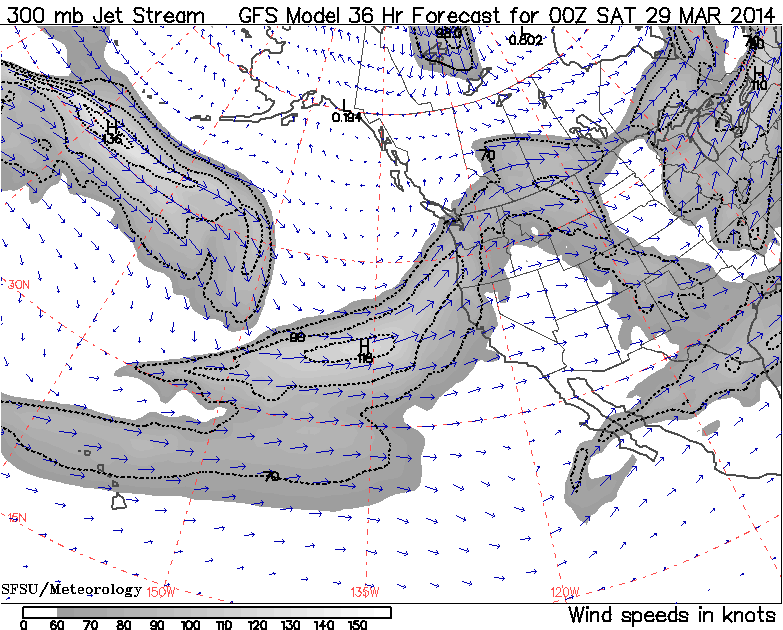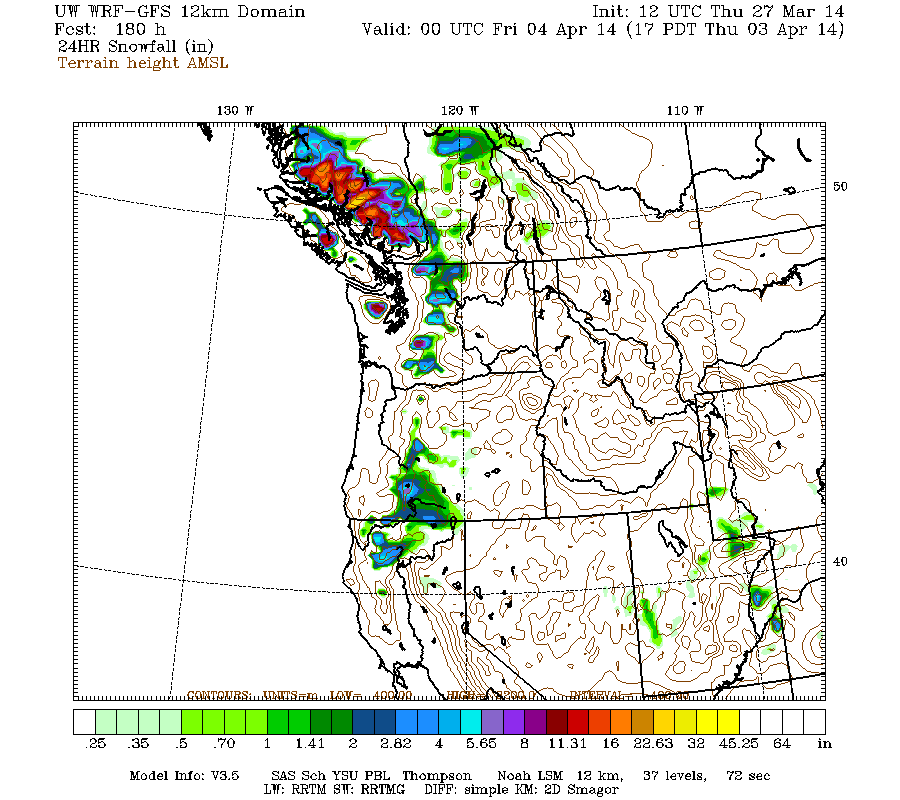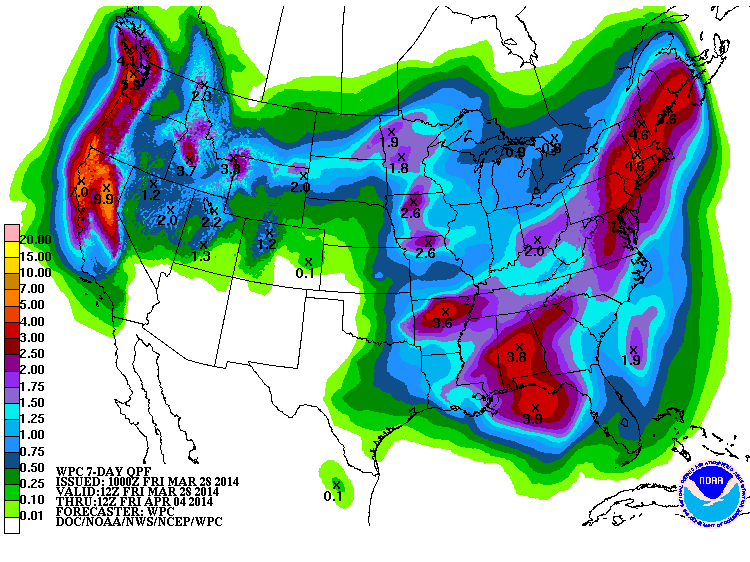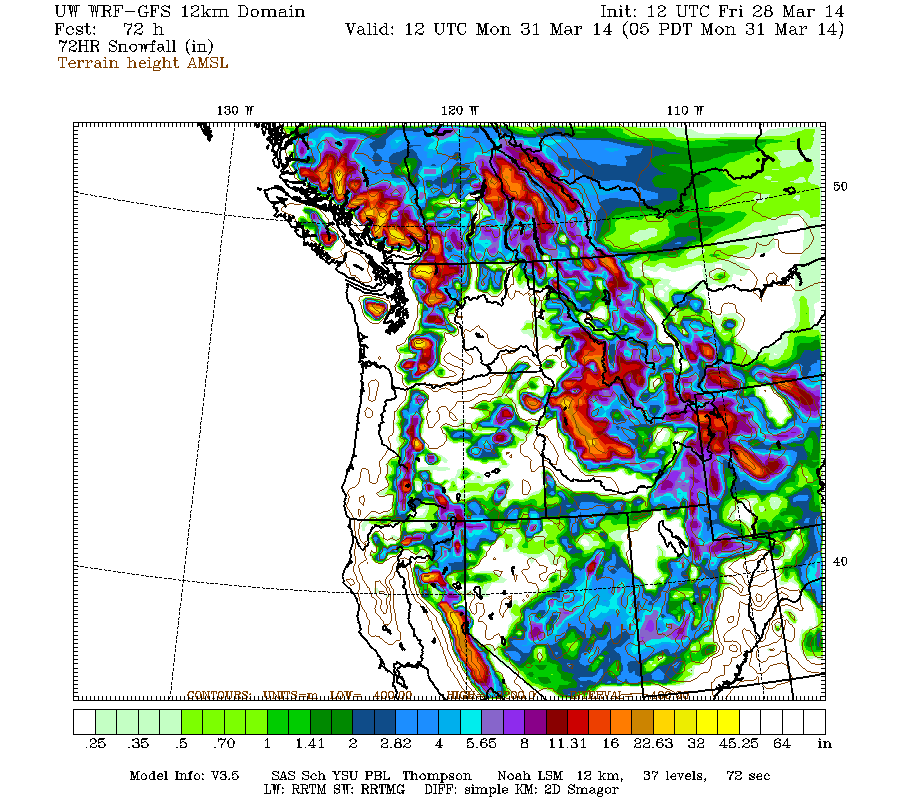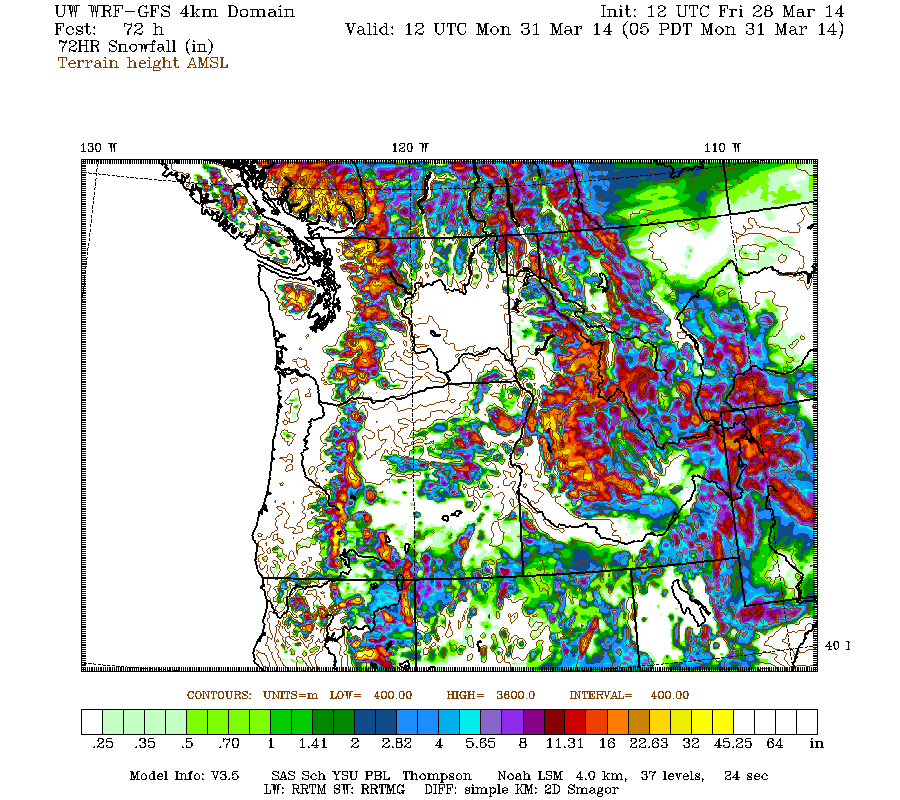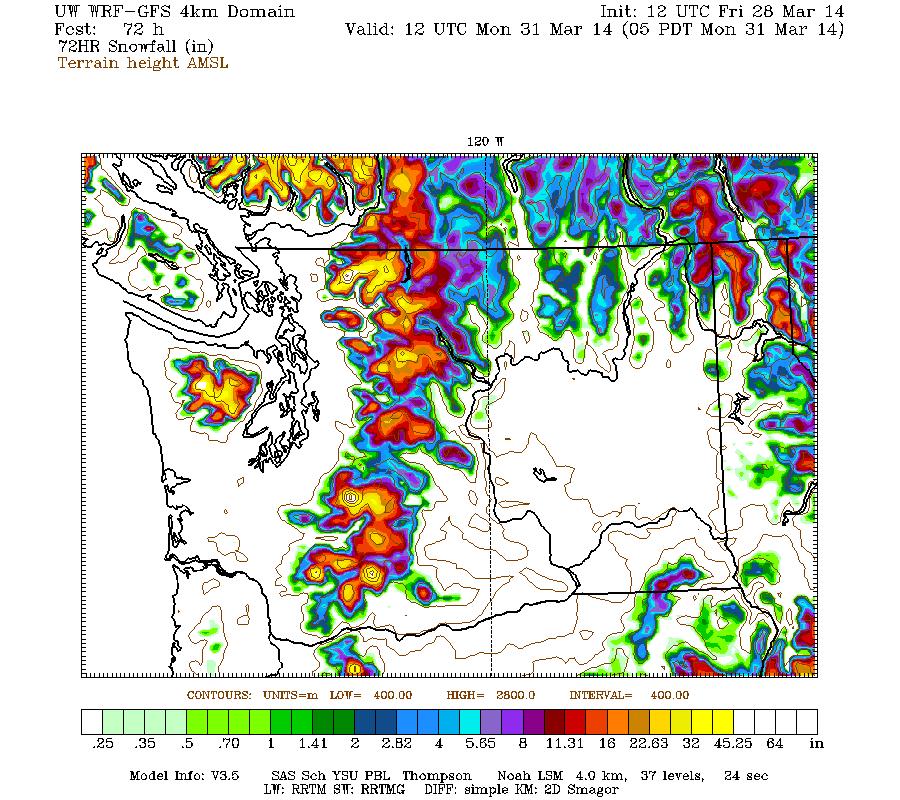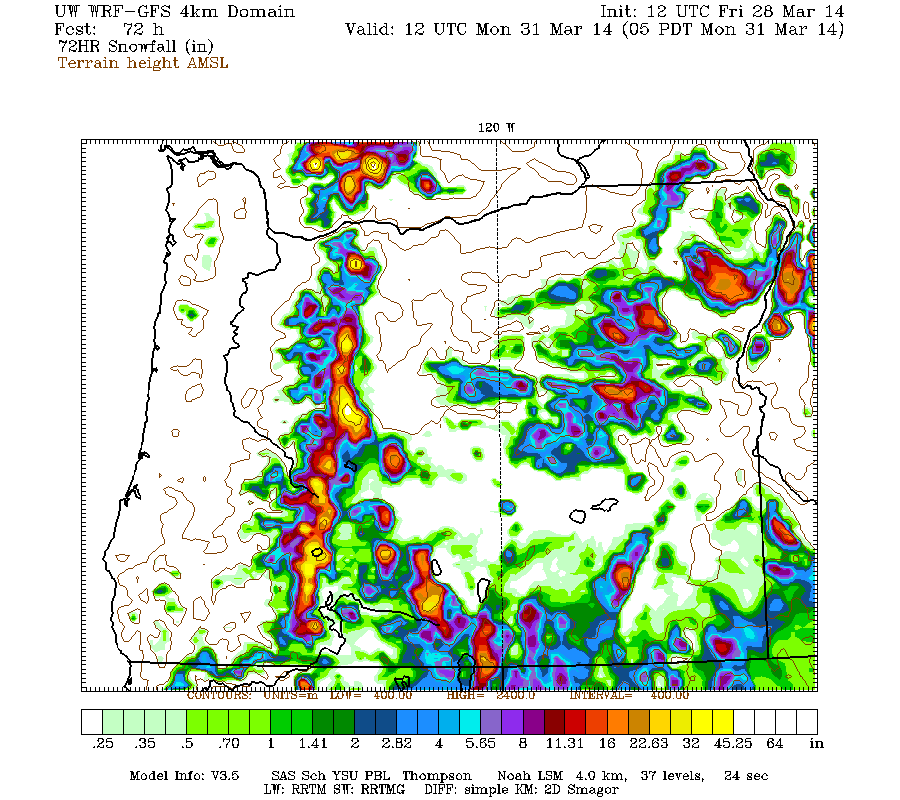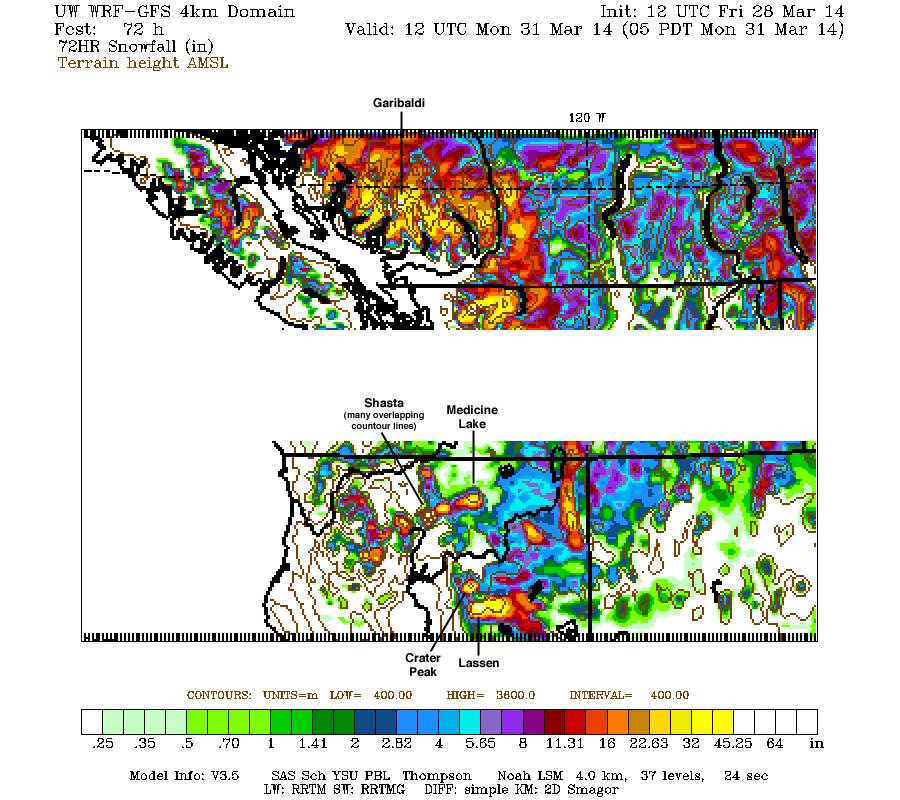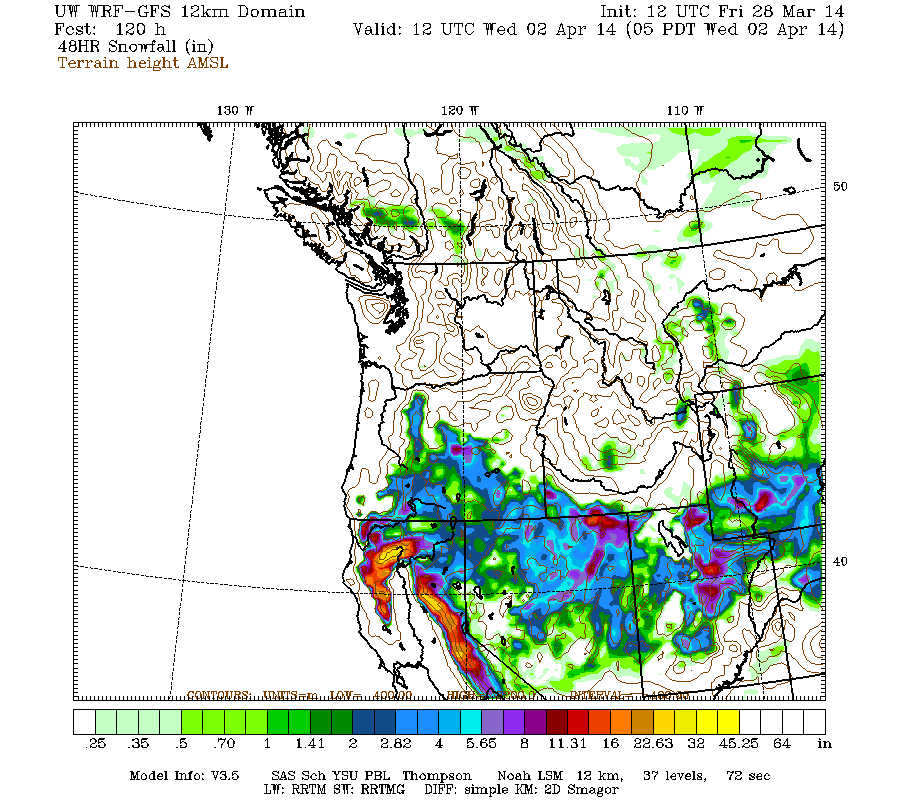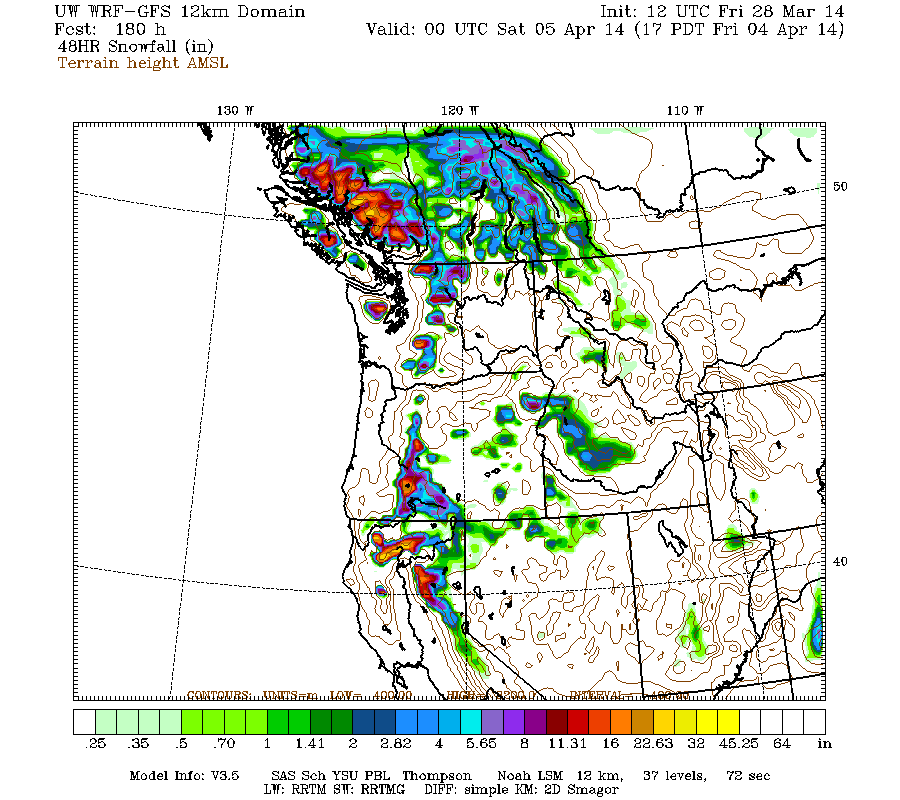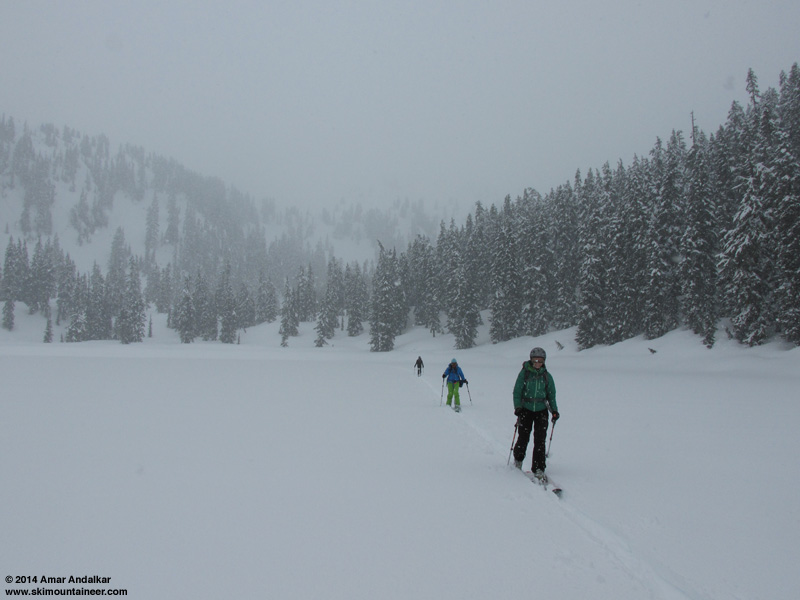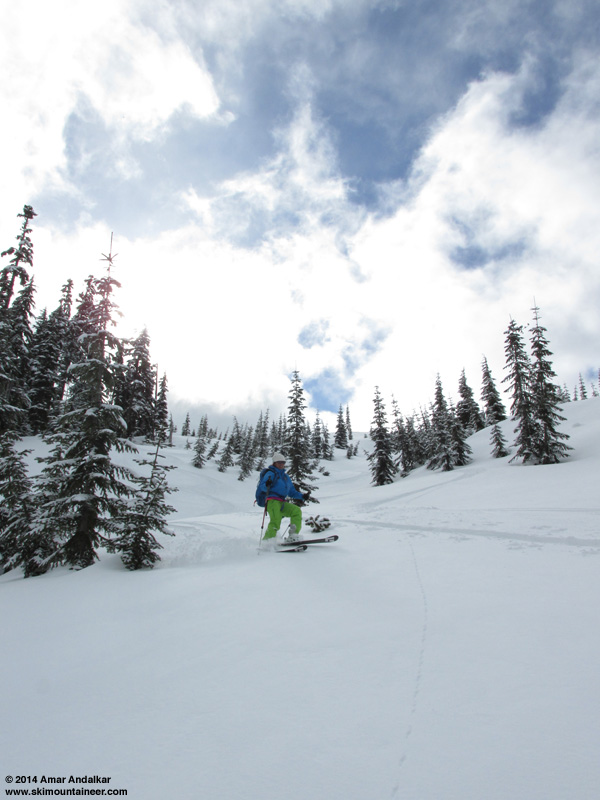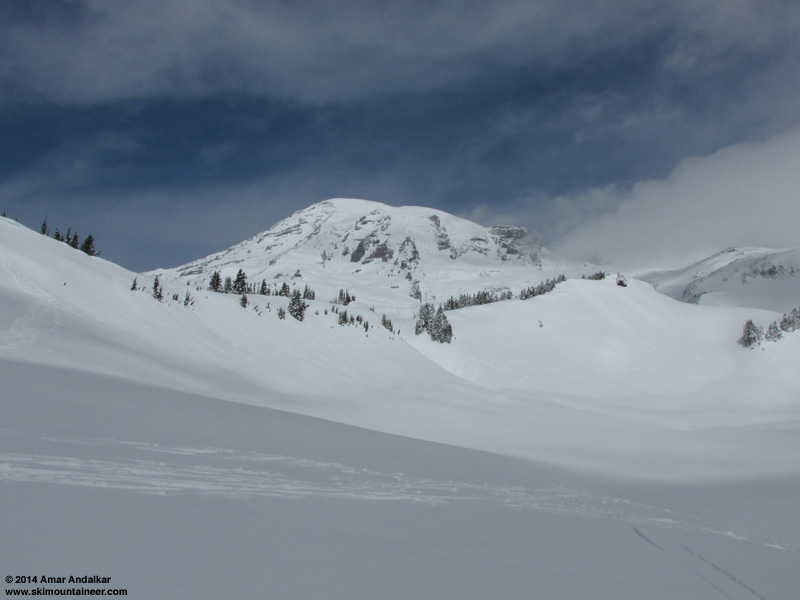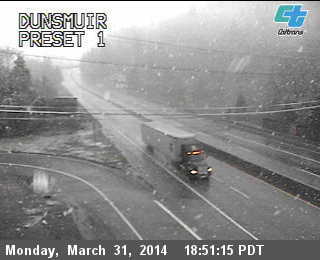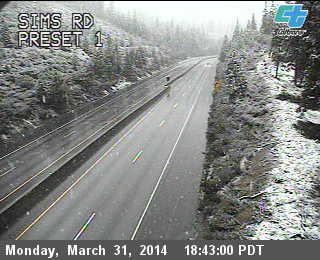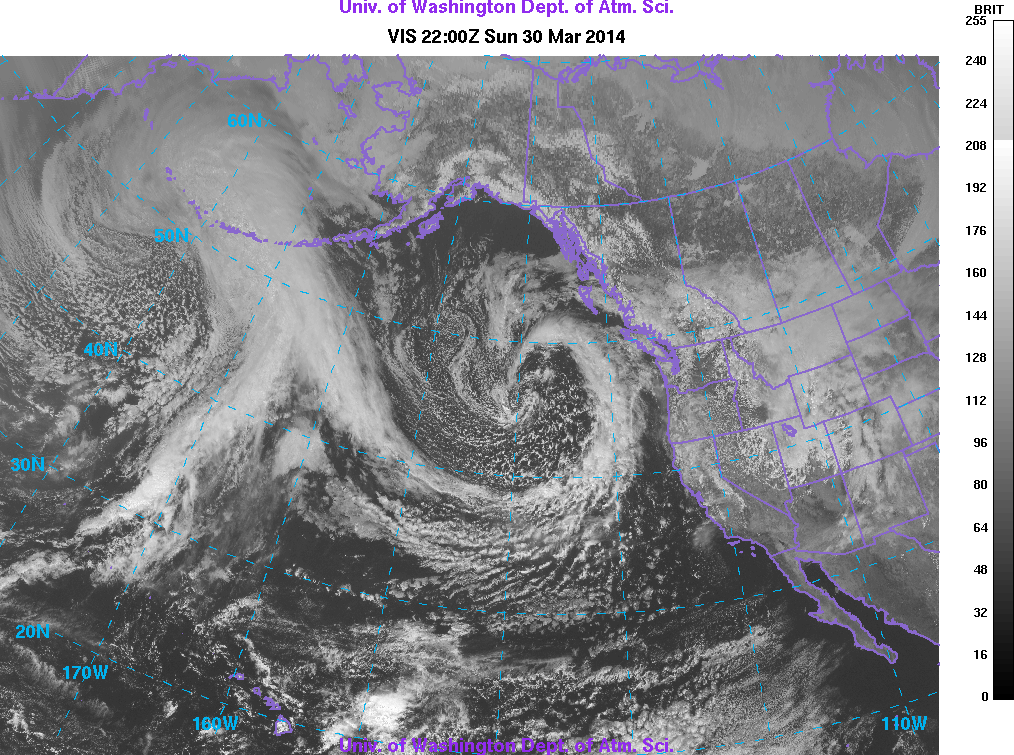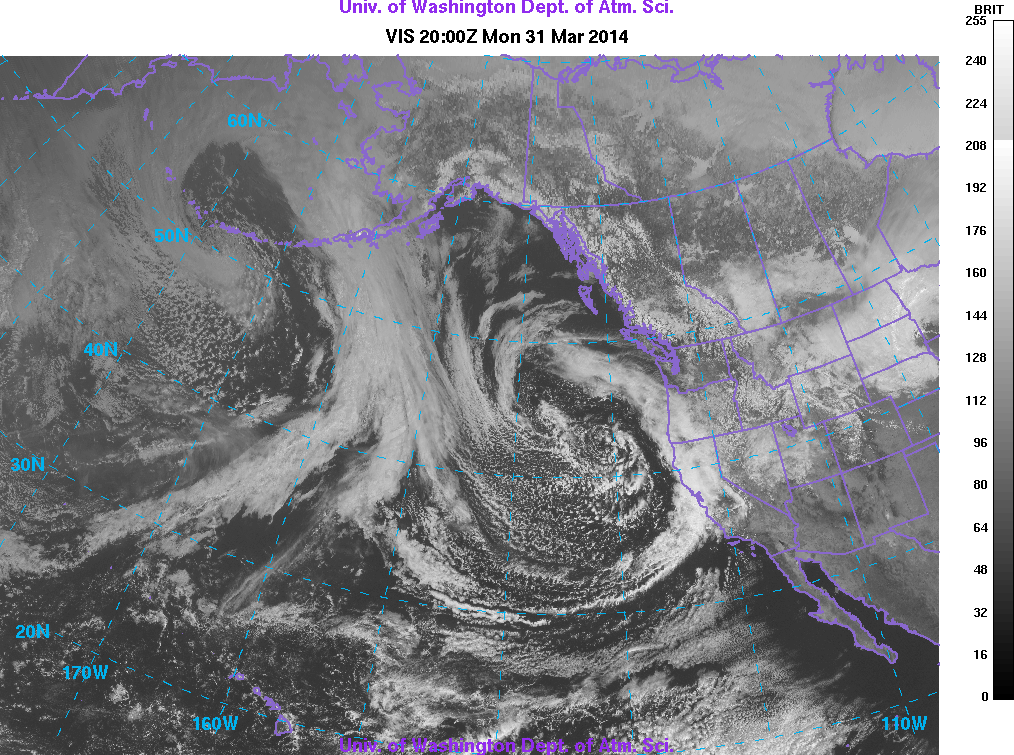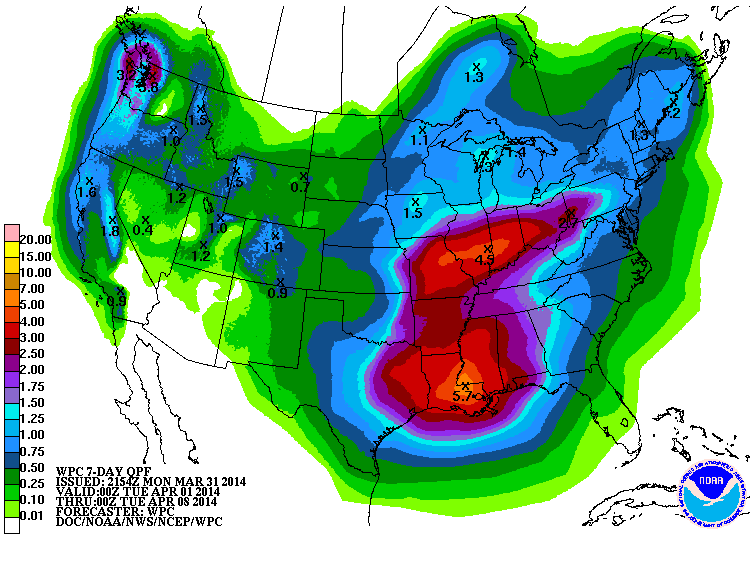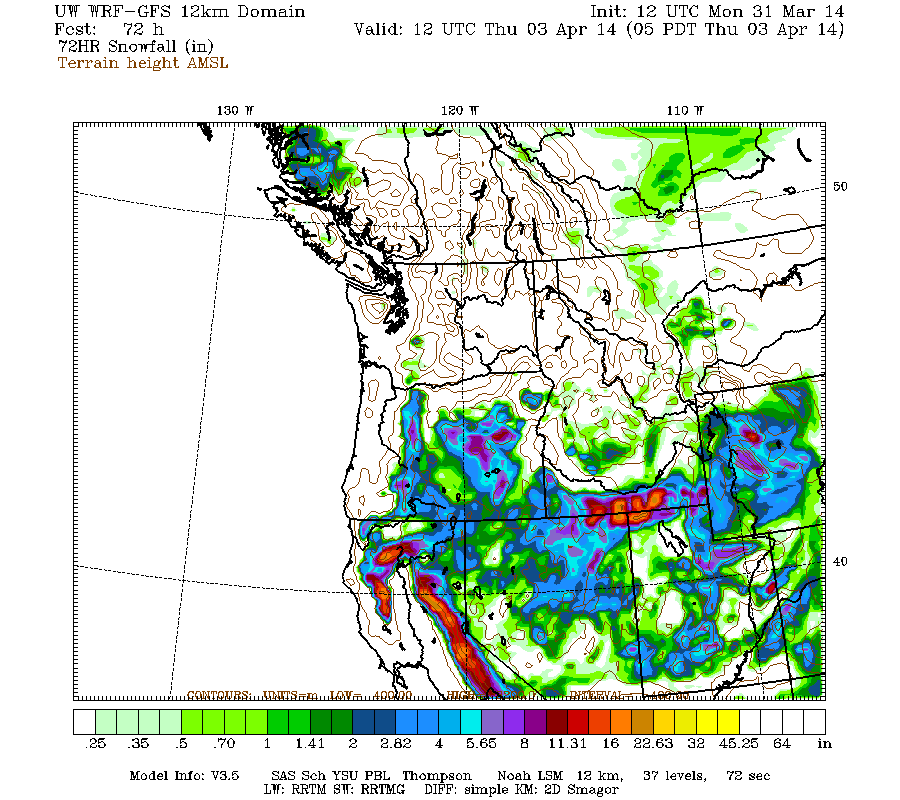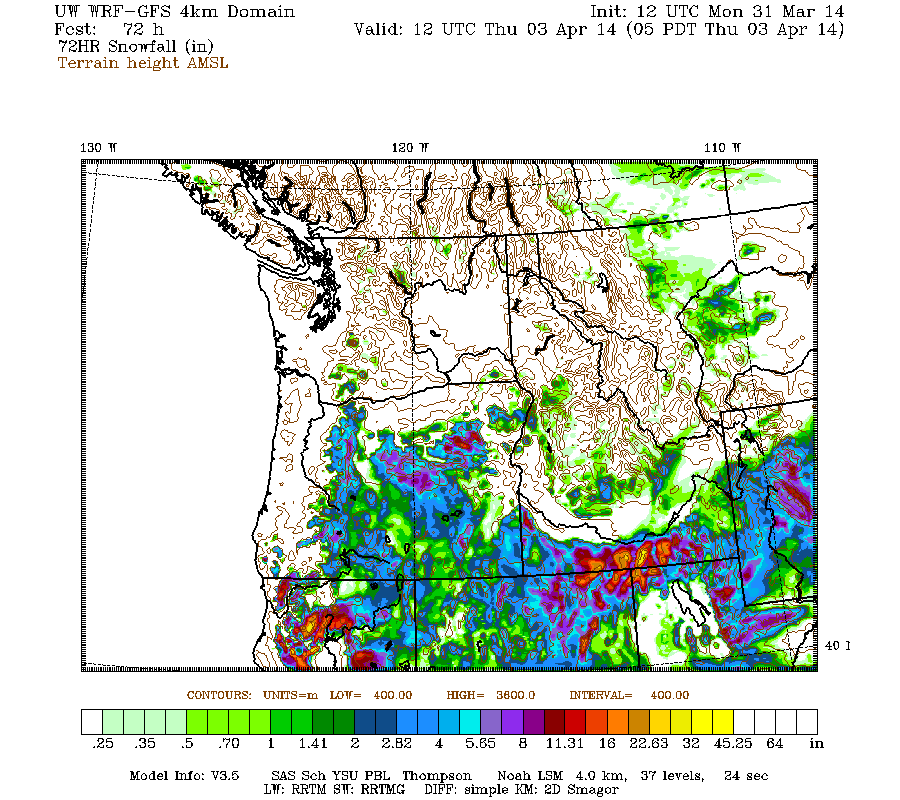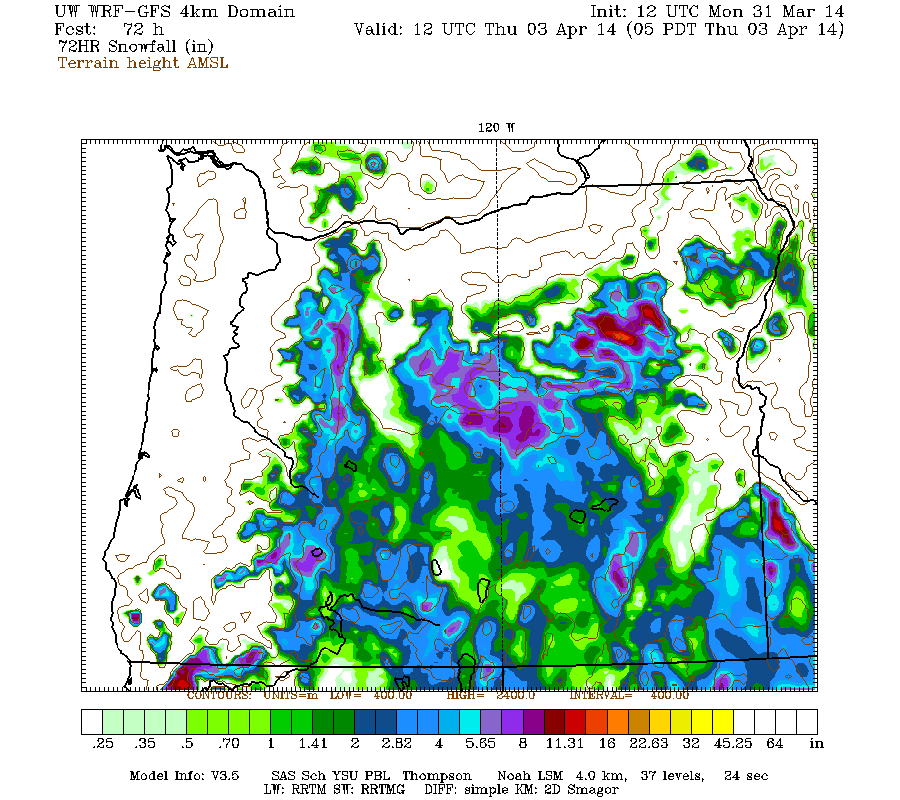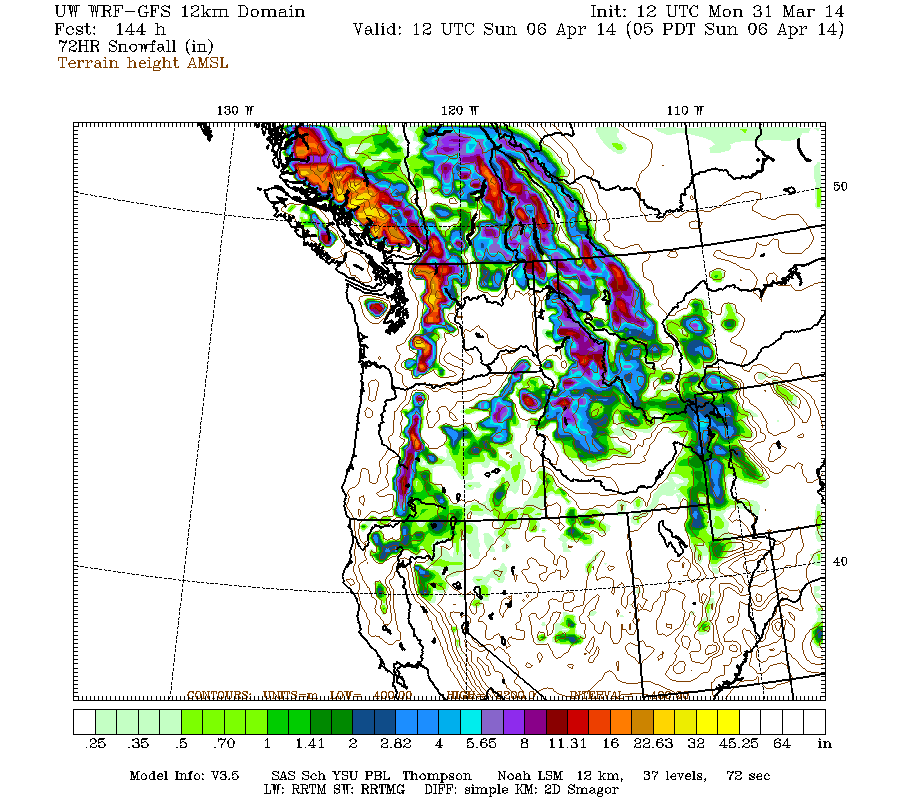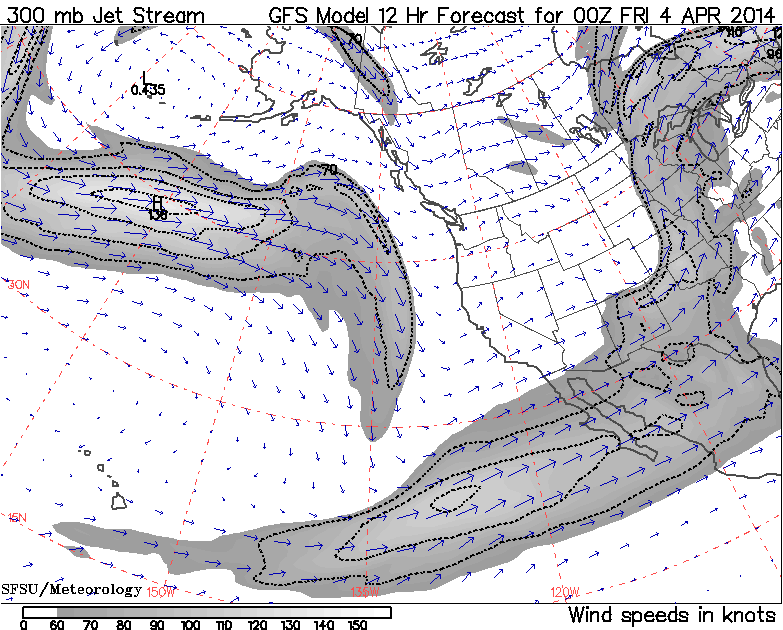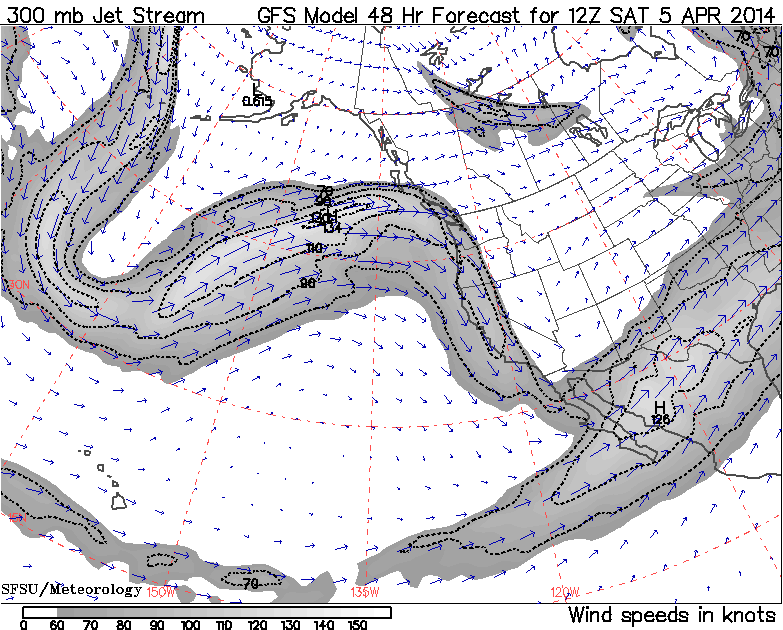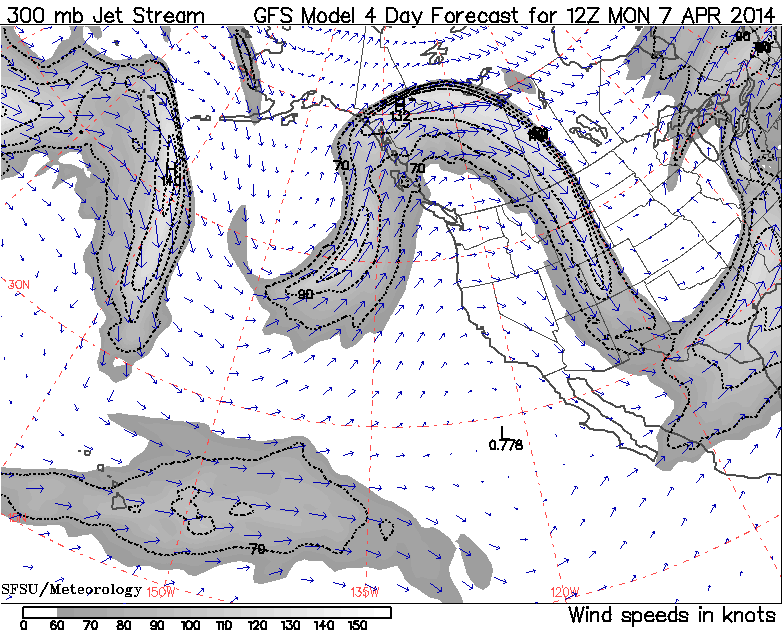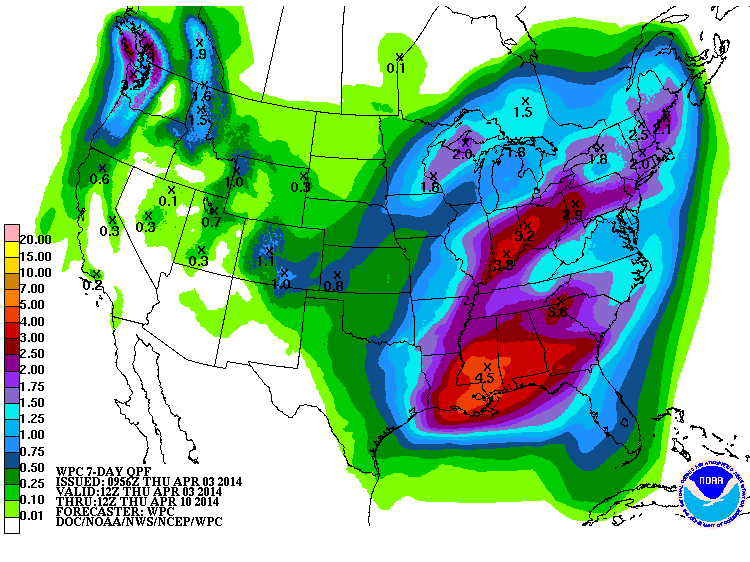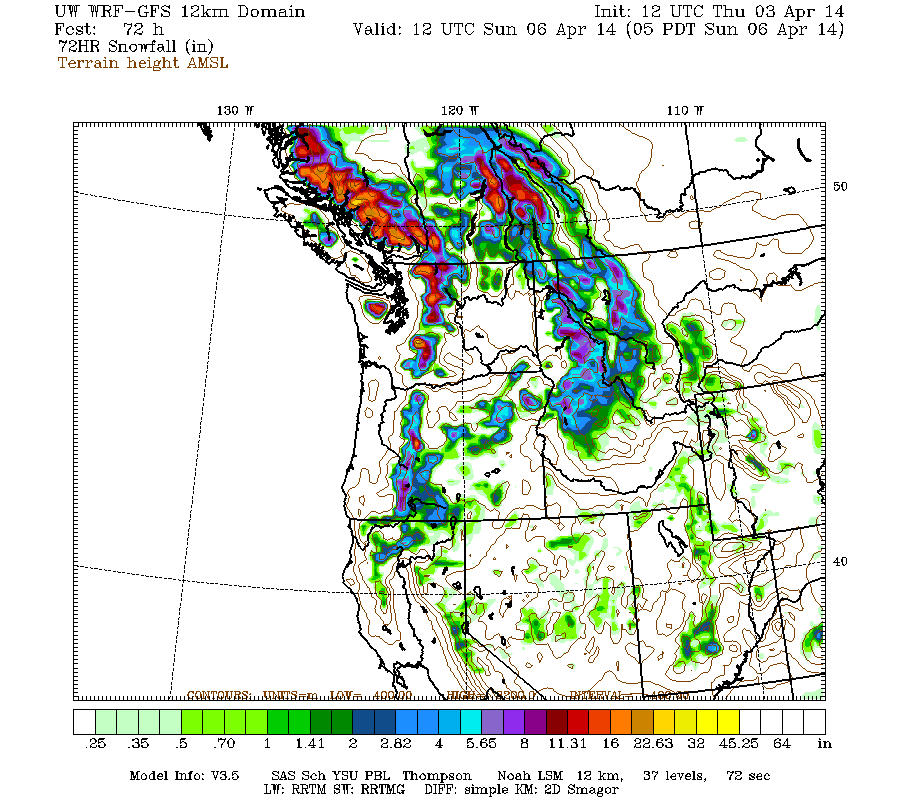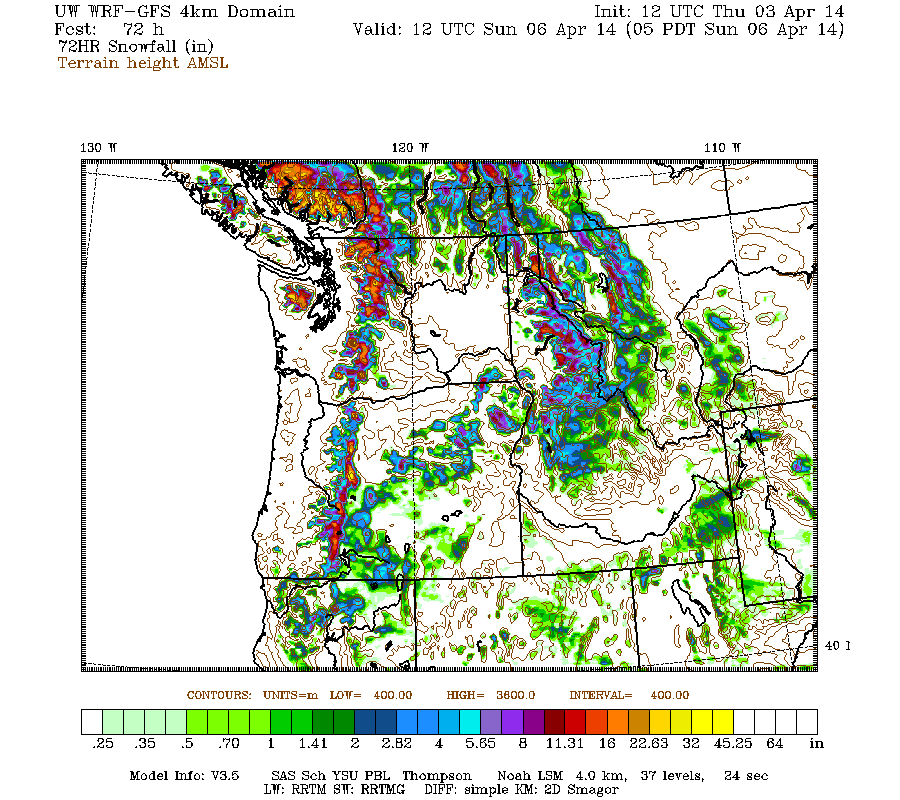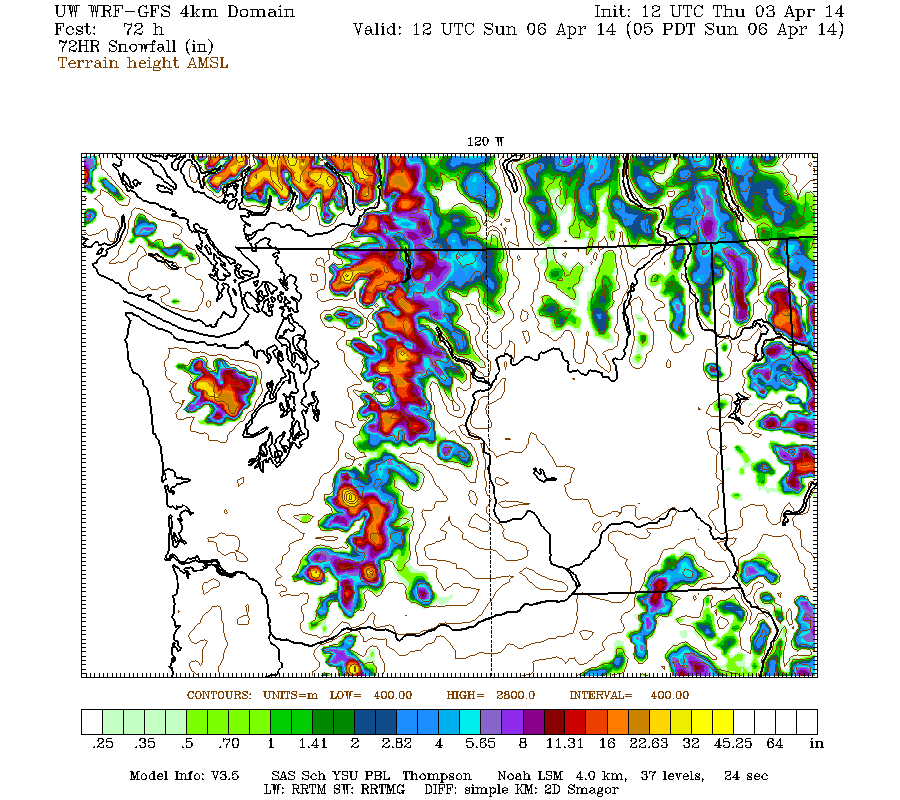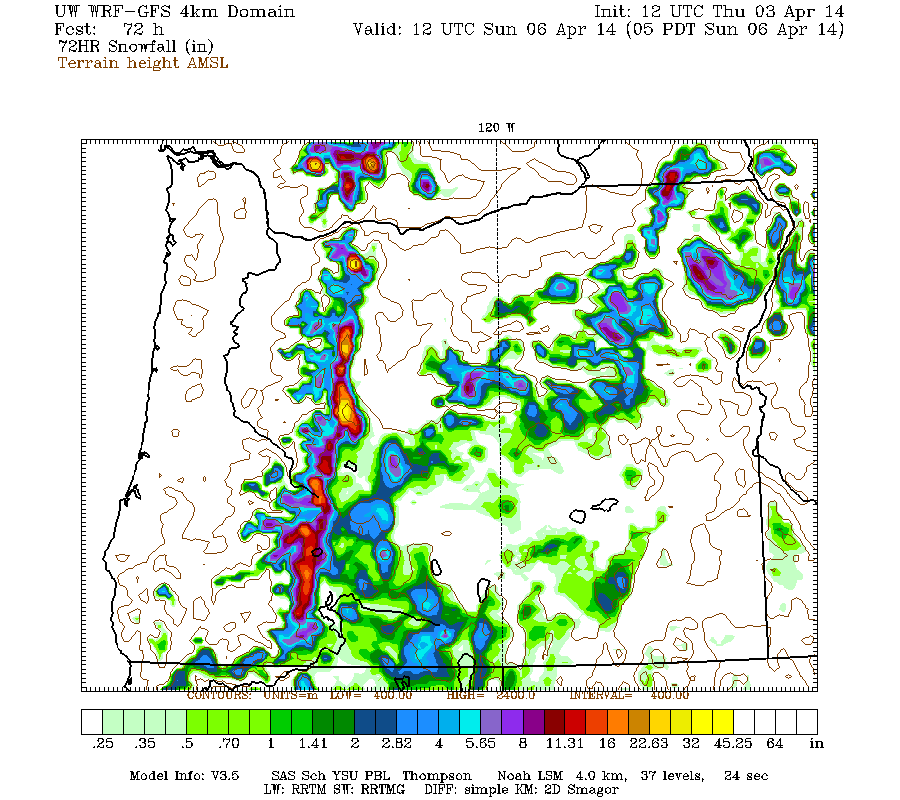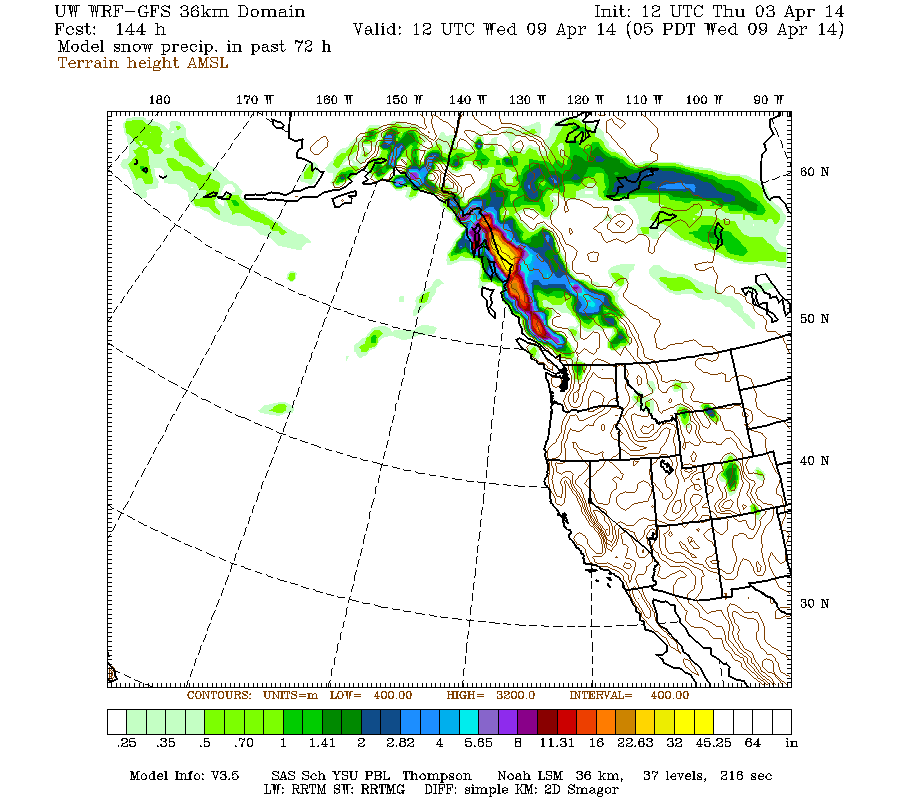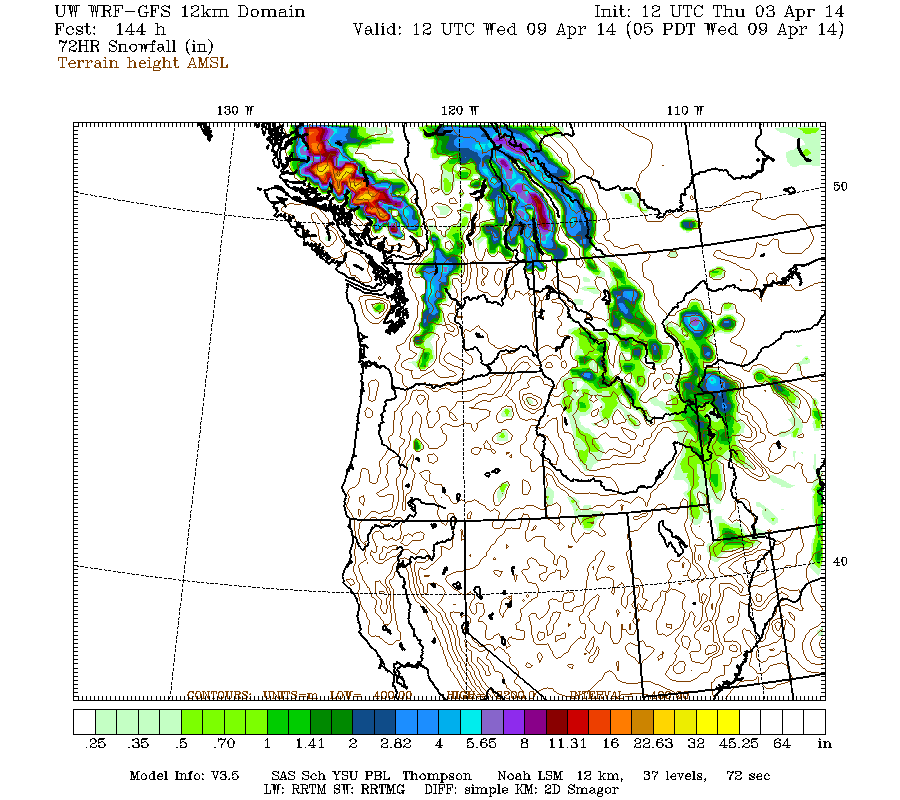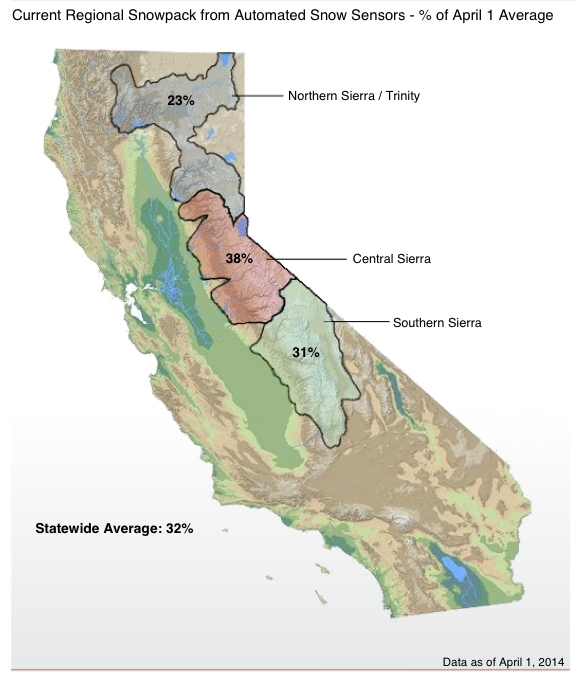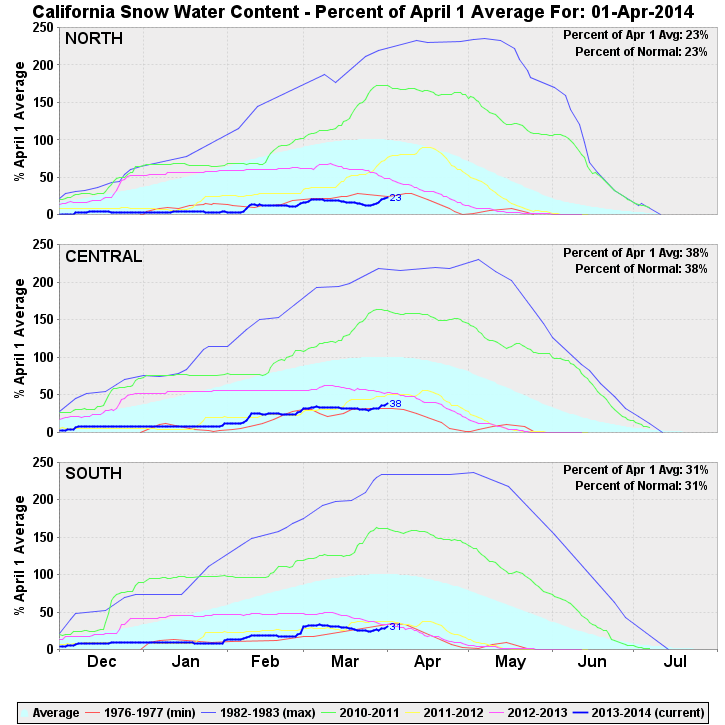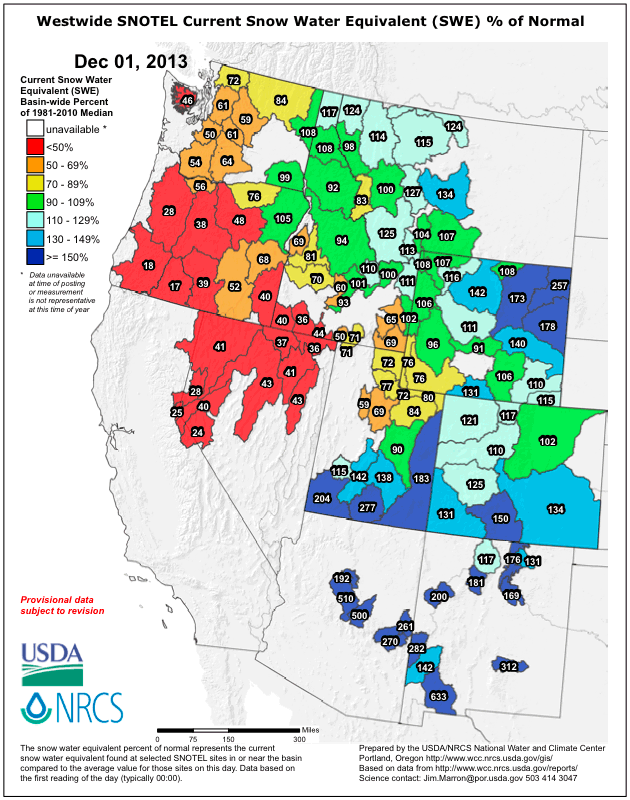- Posts: 635
- Thank you received: 0
Spring storm cycle, 4-10 ft snow Mar25-Apr7,2014!
- Amar Andalkar
- [andalkar]
-
 Topic Author
Topic Author
- Offline
- Premium Member
-

[size=small]See also earlier threads:
First major storm cycle of the 2013-14 season brings 4-8 ft of snow (January 7-14, 2014)
Another major storm cycle brings 2-5 ft of snow (January 28-February 1, 2014)
HUGE storm cycle brings 4-14 ft of snow (February 6-25, 2014)
New storm cycle brings 4-8 ft of snow (February 26-March 10, 2014) [/size]
[size=small]Well, this one looks like it will be very interesting and lots of fun to write about! So here's another storm cycle thread:[/size]
After a highly atypical start to March 2014, with a very wet and fairly warm storm cycle including a pair of atmospheric river events more reminiscent of November than March, the middle part of the month from March 11-24 delivered very typical March weather: a few moderate storm systems each bringing up to 1-2 ft of snow to the Pacific Northwest, with clear sunny periods in between, and extended dry sunny weather throughout the entire 2 weeks in California. But weather models during the past several days have been indicating a major and sustained pattern change, and that change has now arrived!

[size=small](click for triple-size version)[/size]
[size=small]The calm before the storms, March 24: Five-shot panorama of Mount Rainier from atop Crystal Mountain, but there's much to see besides just the Mountain here. Of particular note are the two large old avalanche crowns and hundreds of new ski tracks in Powder Bowl at left, having opened for hike-to access the previous afternoon for the first time since the massive Throne avalanche destroyed the High Campbell lift on March 10, and also the bright glow on the forested hillside at right, far below in the White River valley. This glow is heiligenschein , or more precisely in this case sylvanshine , a retroreflection from dew-covered coniferous trees which have a waxy cuticle on their needles, which produces this bright glow at the antisolar point.[/size]
The first in what is expected to be a lengthy series of storm systems reached the West Coast late on the evening of Monday, March 24, with snowfall at higher-elevation coastal mountain sites beginning by midnight on Tuesday, March 25. Models predict that additional storms will arrive every 1-2 days throughout the rest of this week and next week too, and in general, the upper-level flow will be primarily westerly most of the time, keeping snow levels moderately low for this time of year. An excellent pattern for producing heavy snowfall down to pass elevations (or slightly below) throughout the Pacific Northwest and most of northern California as far south as the central Sierra Nevada. Best of all, the heaviest precipitation and snowfall is expected to occur over the region that needs it the most: southern Oregon and northern California, where the snowpack as a percent of normal is lowest and the drought situation is most critical. But all of the West Coast mountains from southwestern BC to northern California should get hammered with snow over the next 1-2 weeks.
Before looking at what's on the way during this storm cycle, here's a look at the current snowpack status as of midnight on March 25, with data from SNOTEL and California Cooperative Snow Surveys :
Near-normal snowpack in the Washington Cascades and not too bad in the Olympics and Mount Hood, but well below-normal for the rest of the northern Oregon Cascades and far below-normal in the southern Oregon Cascades, California Cascades, Trinity Alps, and Sierra Nevada. In all 3 regions of the California map, this graph shows that the snowpack has now dropped to record low values as of March 25, below the previous record lows of the 1976-77 drought season:
In the northern region, the snowpack is only 13% of normal and about half (!) of the previous record low for this date. Statistically, this is an almost inconceivably low and extraordinarily unlikely value for the snowpack so close to the normal April 1 seasonal maximum, especially averaged over such a large and normally well-watered region. The three largest reservoirs in California (Shasta Lake, Lake Oroville, and Trinity Lake) are located within that critically-low northern region. However, despite record-low precip and a snowpack less than half of the 1976-77 drought season, California reservoir levels remain above those of 1977, probably due to changes in conservation and management practices. Nevertheless the California water supply is not looking good at all:
But this should help the dire situation somewhat: the NWS's GFS model and their Quantitative Precipitation Forecasts are showing up to 6-12" of precip over the next week for the mountains of Washington, Oregon, and northern California, with 1-3" extending north into southwestern BC. Here is total precipitation in inches predicted over the next 7 days through the morning of Tuesday, April 1:
The high-resolution UW WRF-GFS model is showing total snowfall amounts up to 4-8 ft or more over the next week for the mountains of southwestern BC, Washington, Oregon, and northern California. Snowfall during the next 3 days from this morning through 5am Friday is predicted to be 2-5 ft over the Oregon Cascades, California Cascades, Trinity Alps, and northern Sierra Nevada, with 1-3 ft for southwestern BC, the Olympics, and Washington Cascades:
Higher resolution version of that, showing the Pacific Northwest and also zoomed in on Washington and Oregon:
Maximum amounts of 4-5 ft (marked by white inside yellow) are shown over the Three Sisters region in Oregon.
This loop shows how the model predictions for snowfall during the 3-day period through 5am Friday have evolved between 10 subsequent runs over the last 5 days, the D(model)/D(t). Very consistent in the overall picture throughout all those runs, with only minor variations in amounts -- the model clearly had a good handle on the start of this storm cycle even 5 days ago:
www.atmos.washington.edu/~ovens/wxloop.c...2+v2014032812///+-st
A strong system is predicted to arrive on Friday, including a modest atmospheric river aimed at southern Oregon and northern California, and additional storm systems are expected to arrive every 1-2 days after that through the weekend and into next week. Additional snowfall during the subsequent 3 days ending 5am next Monday is predicted to be comparable to the first 3 days (or greater in WA and BC) and the heaviest snowfall may extend over a larger area, with another 2-4 ft expected over southwestern BC, the entire Cascade Range, and the northern Sierra Nevada:
The D(model)/D(t) for that 3-day period has been fairly consistent thus far, although there have been only 4 model runs so far extending out to that period:
www.atmos.washington.edu/~ovens/wxloop.c...2+v2014033112///+-st
After a possible brief lull at the end of the weekend, another system next Monday-Tuesday will bring another shot of heavy snowfall, with 1-3 ft in the Sierra and about 1 ft extending north through Oregon during the 24-hour period ending at 5pm next Tuesday:
Details of that period will continue to change as it draws closer, as it is still 6-7 days out, near the limit of accurate numerical weather prediction. Especially so given that the evolution of the several storm systems prior to the weekend will have a significant effect on the development of the subsequent systems, and on upcoming model predictions.
What about the longer term? A definite end to this storm cycle is not yet in sight. The extended GFS model out to 384 hours (16 days) shows additional storm systems throughout the 8-16 day period, although it is best to ignore specific details and amounts that far out. This is the predicted 24-hour precip, click "Loop All" to see all the graphics (3 hour intervals up to 192 hours, 12 hour intervals beyond that):
GFS, North Pacific, 03/25/2014 12UTC, precip_p24
The Climate Prediction Center's broad-brush probabilistic 6-10 and 8-14 Day Outlooks also look promising, with a high likelihood for continued above-normal precipitation at near-to-below normal temperatures in the Pacific Northwest:
Please Log in or Create an account to join the conversation.
- Charlie Hagedorn
- [trumpetsailor]
-

- Offline
- Elite Member
-

- Posts: 913
- Thank you received: 1
Please Log in or Create an account to join the conversation.
- runningclouds
- [runningclouds]
-

- Offline
- Junior Member
-

- Posts: 141
- Thank you received: 0
What do you think of snow-forecast.com? Do you know which models they use?
Please Log in or Create an account to join the conversation.
- pipedream
- [pipedream]
-

- Offline
- Premium Member
-

- Posts: 629
- Thank you received: 0
Excellent analysis, Amar. Looking forward to the cycles!
Please Log in or Create an account to join the conversation.
- joeb
- [joeb]
-

- Offline
- New Member
-

- Posts: 28
- Thank you received: 0
Appreciate the post and really like that panorama shot.
Don't like the sound of "atmospheric river event" though, particularly if we get a big new snow load this week.
Please Log in or Create an account to join the conversation.
- nemolonsdale
- [nemolonsdale]
-

- Offline
- New Member
-

- Posts: 26
- Thank you received: 0
Looking good for splitfest!
Please Log in or Create an account to join the conversation.
- swaterfall
- [swaterfall]
-

- Offline
- New Member
-

- Posts: 45
- Thank you received: 0
Please Log in or Create an account to join the conversation.
- Amar Andalkar
- [andalkar]
-
 Topic Author
Topic Author
- Offline
- Premium Member
-

- Posts: 635
- Thank you received: 0
Update #1: 24 hours after initial post, up to 1 ft of new snow has already fallen from southwestern BC to northern California,
with an additional 4-10 ft (perhaps more) still predicted over that region during the rest of March and into early April!
This major spring storm cycle is now well underway as of midday Wednesday, with new snowfall of a few inches to over 1 ft during the past 36 hours since midnight Monday-Tuesday extending from the central BC Coast Mountains near Smithers all the way to the southern end of the Sierra Nevada, a distance of over 1400 miles as the crow flies. Maximum 24-hour amounts reported as of Wednesday morning include 14" new at Whistler Mountain, 13" at Buckinghorse SNOTEL in the Olympics, 12" at Mount Baker Ski Area, and 10" at the summit of the Kirkwood, Sierra-at-Tahoe, and Mammoth Mountain ski areas in California. Not a very strong or very wet first system, but a very large one as seen in this visible satellite image from 4pm PDT Monday while the system was still off the West Coast:
Quite interestingly, there were actually two low-pressure centers (one west of Oregon, the other west of the central BC coast) rotating about each other like a spinning dumbbell, see this animation of all Monday and Tuesday visible satellite images:
www.atmos.washington.edu/~ovens/wxloop.c...4032602+interval+30m
Model predictions continue on track with very heavy precip and snowfall expected over much of the West Coast during the next 7 days and beyond. The NWS's GFS model and their Quantitative Precipitation Forecasts are showing up to 6-10" of additional precip over the next week for the mountains of Washington, Oregon, and northern California, with 3-5" extending north into southwestern BC. Here is total precipitation in inches predicted over the next 7 days through the afternoon of Wednesday, April 2:
A day later, and 2 subsequent runs of the high-resolution UW WRF-GFS model at 12-hour intervals continue to predict large snowfall amounts up to 4-8 ft or more over the next week for the mountains of southwestern BC, Washington, Oregon, and northern California. Snowfall during the next 3 days from this morning through 5am Saturday is predicted to be 2-6 ft over the Oregon Cascades, California Cascades, Trinity Alps, and northern Sierra Nevada, with 1-3 ft for southwestern BC, the Olympics, and Washington Cascades:
This loop shows how the model predictions for snowfall during the 3-day period through 5am Saturday have evolved between 10 subsequent runs over the last 5 days, the D(model)/D(t). Very consistent in the overall picture throughout all those runs, with only minor variations in amounts -- so these model predictions are very likely to actually happen:
www.atmos.washington.edu/~ovens/wxloop.c...2+v2014032912///+-st
Higher resolution version of that, showing the Pacific Northwest and also zoomed in on Washington and Oregon:
Maximum amounts of 4-6 ft (marked by white inside yellow) are shown on Mount Rainier, Mount Saint Helens, almost the entire Cascade Range in Oregon (above the 1600 m / 5300 ft contour), Mount Shasta, and Lassen Peak. In Oregon, this is by far the largest area with predicted 3-day amounts over 4 ft shown in any graphic in any of the 5 storm cycle threads thus far. If the model prediction verifies, this will be the largest 3-day snowfall in the central and southern Oregon Cascades of the entire 2013-14 season thus far. Even Newberry Volcano and Yamsay Mountain (another large shield volcano east of Crater Lake, the highest volcano in the eastern Cascade chain at 8196 ft) are shown with 3 ft of snowfall expected, unusual given that both are 30 miles east of the Cascade Crest and normally quite rain-shadowed! Some major volcanoes have been labeled on the last graphic for clarity.
The extremely heavy snowfall in Oregon will occur during two separate systems, one from today into Thursday, and the other on Friday into Saturday. The 24-hour amounts during the first system through 5pm Thursday are predicted to top 2 ft on many of the volcanoes, with snowfall extending down to quite low elevations (3-4000 ft) for this time of year in that region:
The 24-hour amounts during the later system through 5am Saturday are predicted to top 3 ft on many of the volcanoes, but snowfall will not extend down to low elevations and will be primarily above 5-6000 ft:
This extremely heavy snowfall coupled with higher snow levels is because the second system will include a moisture plume from a moderately-strong, moderately-warm atmospheric river aimed at southern Oregon and northern California. But this one is not nearly as strong, wet, or warm as the other earlier atmospheric river events which were part of the February 6-25 or February 26-March 10 storm cycles, which had snow levels exceeding 8-9000 ft at times. Here is the predicted moisture plume at its peak on Friday afternoon, showing that it originates in the subtropics around 28-30° N latitude, well north of Hawaii (located just off the lower left corner of the image) rather than in the tropics near Hawaii at 20° N like those earlier atmospheric river events:
More storm systems are expected to arrive every 1-2 days after that through the weekend and into next week. Additional snowfall during the subsequent 3 days ending 5am next Tuesday (April 1) is predicted to be 2-5 ft over the Sierra Nevada, Trinity Alps, and California Cascades, with 1-2 ft extending north through Oregon and Washington into southwestern BC:
The D(model)/D(t) for that 3-day period has also been fairly consistent thus far, with amounts increasing a bit in California on more recent runs, although there have been only 4 model runs so far extending out to that period:
www.atmos.washington.edu/~ovens/wxloop.c...2+v2014040112///+-st
Another system next Tuesday may bring another shot of heavy snowfall primarily to California, with up to 1 ft there and much lighter amounts extending north through Oregon into Washington during the 24-hour period ending at 5am next Wednesday:
Details of that period will continue to change as it draws closer, as it is still 6-7 days out, near the limit of accurate numerical weather prediction. Especially so given that the evolution of the several storm systems prior to the weekend will have a significant effect on the development of the subsequent systems, and on upcoming model predictions.
What about the longer term? A definite end to this storm cycle is still not yet in sight. The extended GFS model out to 384 hours (16 days) shows additional storm systems throughout the 8-16 day period, although it is best to ignore specific details and amounts that far out. Nevertheless, it currently shows a lull next Wednesday and then another system affecting much of the West Coast on Thursday, April 3, followed by additional systems every 1-3 days through Friday April 11. This is the predicted 24-hour precip, click "Loop All" to see all the graphics (3 hour intervals up to 192 hours, 12 hour intervals beyond that):
GFS, North Pacific, 03/26/2014 12UTC, precip_p24
It certainly looks like a very stormy and snowy pattern extending well into April!
Please Log in or Create an account to join the conversation.
- Amar Andalkar
- [andalkar]
-
 Topic Author
Topic Author
- Offline
- Premium Member
-

- Posts: 635
- Thank you received: 0
Update #2: 48 hours after initial post, up to 1-2 ft of new snow has already fallen from southwestern BC to northern California,
with an additional 4-8 ft (perhaps more) still predicted over that region during the rest of March and into early April!
The ongoing spring storm cycle is proceeding largely as expected, with the heaviest snowfall of 1 ft or greater during the second system from Wednesday through Thursday shifting south into southernmost Washington, Oregon, and California, but lighter amounts of a few inches still extending all the way north to the central BC coast. Maximum 30-hour new snow amounts through midday Thursday include 16" at Swift Creek SNOTEL (4440 ft) and 15" at June Lake SNOTEL (only 3440 ft!) on Mount Saint Helens, 18" at Timberline and 16" at Mount Hood Meadows, 11" at Mount Bachelor, 9" at Crater Lake, and 15" atop Sugar Bowl, 13" atop Squaw Valley, and 10" atop Mammoth Mountain in California. Heavy snowfall continues in southern Washington and Oregon on Thursday, but has tapered off in California.
[size=small]Mount Shasta trying to clear out between storm systems on Thursday afternoon, as seen on the SnowCrest webcam .[/size]
[size=small]Mammoth Mountain clears briefly between storm systems on Thursday morning after 15-20" of new snow the past 2 days, as seen on the Caltrans webcam .[/size]
Model predictions continue on track with very heavy precip and snowfall expected over much of the West Coast during the next 7 days and beyond. The NWS's GFS model and their Quantitative Precipitation Forecasts are showing up to 6-9" of additional precip over the next week for the mountains of Washington, Oregon, and northern California, with 3-5" extending north into southwestern BC. Here is total precipitation in inches predicted over the next 7 days through the afternoon of Thursday, April 3:
The precip during a single 24-hour period from Friday to Saturday afternoon may exceed 5-6" in the California Cascades, courtesy of the moderately-strong atmospheric river detailed in the previous update above, with the bullseye here shown on Lassen Peak:
Another day later, and 2 subsequent runs of the high-resolution UW WRF-GFS model at 12-hour intervals continue to predict large snowfall amounts up to 4-8 ft or more over the next week for the mountains of southwestern BC, Washington, Oregon, and northern California. The strongest and wettest system of this storm cycle thus far will arrive early on Friday and extend through Saturday, bringing heavy precip and snowfall over the entire region. Snowfall during the next 3 days from this morning through 5am Sunday is predicted to be 2-5 ft from southwestern BC through the entire length of the Cascade Range and into the southern Sierra Nevada, a span of over 1000 miles:
Higher resolution version of that, showing the Pacific Northwest and also zoomed in on Washington and Oregon:
Maximum amounts of 4-5 ft (marked by white inside yellow) are shown on Mounts Baker, Rainier, Adams, and Saint Helens in Washington, on Mounts Hood, Jefferson, Bachelor, the Three Sisters, and Diamond Peak in Oregon, and in California on Mount Shasta, Lassen Peak, and even the massive shield of Medicine Lake Volcano, an unusually high amount since it's located 30 miles ENE of Shasta and normally quite rain-shadowed. It's hard to see the amounts for the California Cascades since there is no zoomed graphic available from the UW model, but I'm simply using a magnifying lens app on my computer to zoom in on the full 4km-domain graphic.
This loop shows how the model predictions for snowfall during the 3-day period through 5am Sunday have evolved between 10 subsequent runs over the last 5 days, the D(model)/D(t). Very consistent in the overall picture throughout all those runs, although with larger run-to-run variation in the oldest runs, then settling down over the most recent ones:
www.atmos.washington.edu/~ovens/wxloop.c...2+v2014033012///+-st
Another weaker system is expected on Sunday, followed by another stronger system on Monday aimed primarily at Oregon and California again. Additional snowfall during the subsequent 3 days ending 5am next Wednesday (April 2) is predicted to be 2-4 ft over the Sierra Nevada, Klamath Mountains, and California Cascades, with 1-2 ft extending north through Oregon and Washington into southwestern BC:
The D(model)/D(t) for that 3-day period has also been fairly consistent thus far, with amounts increasing a bit in California on more recent runs, although there have been only 4 model runs so far extending out to that period:
www.atmos.washington.edu/~ovens/wxloop.c...2+v2014040212///+-st
The strong system on Monday is expected to be quite different from the one on Friday, with much lower snow levels due to northwesterly and westerly flow over the Pacific, as seen in the jet stream forecasts . Here is the predicted jet stream at 5pm PDT Friday, with primarily southwesterly flow associated with the atmospheric river, and then at 5am PDT Monday, showing the complete change in configuration and direction over that period:
After a lull on Wednesday, another system is still predicted by Thursday, with significant snowfall increasing during the 24-hour period ending at 5pm next Thursday, April 3 (and expected to continue through Friday):
And there's still no definite end to this storm cycle in sight as of yet, as the extended GFS model out to 384 hours (16 days) continues to show additional storm systems throughout the 8-16 day period, although it is best to ignore specific details and amounts that far out. This is the predicted 24-hour precip, click "Loop All" to see all the graphics (3 hour intervals up to 192 hours, 12 hour intervals beyond that):
GFS, North Pacific, 03/27/2014 12UTC, precip_p24
Still on course for a very snowy start to April!
Please Log in or Create an account to join the conversation.
- Amar Andalkar
- [andalkar]
-
 Topic Author
Topic Author
- Offline
- Premium Member
-

- Posts: 635
- Thank you received: 0
with an additional 4-8 ft (perhaps more) still predicted over that region during the rest of March and into early April!
Snowfall from the second system of this spring storm cycle continued through Thursday, heaviest over Oregon with maximum 24-hour new snow amounts through day's end near 1 ft on Mount Hood, but once again with light amounts extending over a vast region of over 1400 miles from the central BC Coast Mountains near Smithers all the way to the southern end of the Sierra Nevada past Mammoth Mountain. The next much stronger system has already reached the coast early on Friday, with heavy precip and snowfall spreading first over southwestern BC, Washington, and Oregon, and later into northern California. This system and its heavy post-frontal snow showers are expected to extend through Saturday, with another round of lighter snow showers on Sunday.
The greatest total snowfall amounts for this storm-cycle thus far through midday Friday are 36" at Timberline Lodge and 31" at Mount Hood Meadows, increasing the snowdepth from 135" to 160" at Timberline and 107" to 131" at Meadows since Tuesday morning. These sites are now once again reaching 100% of normal snowdepth for the first time in over a month since the huge February storm cycle ended. Total precip thus far has been over 5" at Timberline and 4" at Meadows, and also over 5" at both Swift Creek SNOTEL (4440 ft) and June Lake SNOTEL (3440 ft) on Mount Saint Helens, and at Bear Grass SNOTEL (4720 ft) west of Mount Washington in Oregon, with snowfall of about 2.5 ft at Bear Grass and Swift Creek but only about 1.5 ft at June Lake due to the lower elevation.
Model predictions continue on track with very heavy precip and snowfall expected over much of the West Coast during at least the next 8 days through Saturday, April 5, and perhaps beyond. The NWS's GFS model and their Quantitative Precipitation Forecasts are showing up to 6-10" of additional precip over the next week for the mountains of Washington, Oregon, and northern California, with 3-5" extending north into southwestern BC. Here is total precipitation in inches predicted over the next 7 days through the morning of Friday, April 4:
Another day later, and 2 subsequent runs of the high-resolution UW WRF-GFS model at 12-hour intervals continue to predict large snowfall amounts up to 4-8 ft or more over the next week for the mountains of southwestern BC, Washington, Oregon, and northern California. Snowfall during the next 3 days from this morning through 5am Monday is predicted to be 2-5 ft from southwestern BC through the entire length of the Cascade Range and into the central Sierra Nevada, a span of about 1000 miles:
Higher resolution version of that, showing the Pacific Northwest and also zoomed in on Washington and Oregon:
Maximum amounts of 4-5 ft (marked by white inside yellow) are shown on Mount Garibaldi in BC, Mounts Olympus, Baker, Rainier, Adams, and Saint Helens in Washington, the Three Sisters in Oregon, and Mount Shasta, Crater Peak (an 8677 ft stratovolcano north of Lassen), and Lassen Peak in California. It's hard to see the highest amounts for southwestern BC or the California Cascades since there is no zoomed graphic available for those areas from the UW model, but I'm simply using a magnifying lens app on my computer to zoom in on the full 4km-domain graphic. Just for fun, I decided to try making a crudely-magnified version of the 4km graphic for southwestern BC and the California Cascades in Photoshop, and it only took several minutes to finish. Here it is with x2 magnification of those areas and several major volcanoes labeled for clarity:
This loop shows how the model predictions for snowfall during the 3-day period through 5am Monday have evolved between 10 subsequent runs over the last 5 days, the D(model)/D(t). Very consistent in the overall picture throughout all those runs, although with larger run-to-run variation in the oldest runs, then settling down over the most recent ones:
www.atmos.washington.edu/~ovens/wxloop.c...2+v2014033112///+-st
Another stronger system is expected to arrive on Monday morning through Tuesday aimed primarily at northern California again, with much lower snow levels as explained in Update #2 above. Additional snowfall during the 2-day period from 5am Monday to Wednesday is predicted to be 2-3 ft over the Sierra Nevada, Klamath Mountains, and California Cascades, with much lighter amounts less than 1 ft extending north through Oregon:
The D(model)/D(t) for that 2-day period has also been fairly consistent thus far, with amounts increasing a bit in California and decreasing farther north on more recent runs, although there have been only 6 model runs so far extending out to that period:
www.atmos.washington.edu/~ovens/wxloop.c...8+v2014040212///+-st
After a lull on Wednesday, another system is still predicted for Thursday through Friday, this time affecting the entire region from southwestern BC to northern California. Additional snowfall during the 2-day period through 5pm Friday April 4 is predicted to be 1-2 ft over that entire span, with greater amounts up to 2-3 ft in parts of southwestern BC, the California Cascades, and Klamath Mountains:
Still no definite end to this storm cycle in sight as of yet, as the extended GFS model out to 384 hours (16 days) continues to show additional storm systems throughout the 8-16 day period, although it is best to ignore specific details and amounts that far out. This is the predicted 24-hour precip, click "Loop All" to see all the graphics (3 hour intervals up to 192 hours, 12 hour intervals beyond that):
GFS, North Pacific, 03/28/2014 12UTC, precip_p24
Looking like a spectacular snowy finish for March and a super snowy start for April!
Please Log in or Create an account to join the conversation.
- filbo
- [filbo]
-

- Offline
- Junior Member
-

- Posts: 184
- Thank you received: 0
Please Log in or Create an account to join the conversation.
- timbat
- [timbat]
-

- Offline
- New Member
-

- Posts: 6
- Thank you received: 0
Please Log in or Create an account to join the conversation.
- sprice
- [sprice]
-

- Offline
- Junior Member
-

- Posts: 66
- Thank you received: 0
awesome! we be geeks!. more words to use at cocktail parties to impress.
Please Log in or Create an account to join the conversation.
- Amar Andalkar
- [andalkar]
-
 Topic Author
Topic Author
- Offline
- Premium Member
-

- Posts: 635
- Thank you received: 0
with an additional 1-3 ft still predicted over that region during the first week of April!
[size=small]Went skiing on Saturday, Sunday, and Monday, so no time to write updates over the weekend. Some brief mini-reports:
Saturday, March 29: Lichtenberg Mountain from the north via Smith Brook Rd, drizzle below 3700 ft, snowing above that. It was decent heavy powder up high above 4700 ft Licthenwasser Lake, but very unstable, with most slopes over 30° readily wet-sluffing the entire recent snowfall of 8-12", even north aspects. Pretty much as expected given the amount of fresh and recent avy debris visible from the highway in every single steep chute in the vicinity. Luckily, Stevens Pass had gotten the short end of the stick during this storm cycle (after doing far better than most other areas during the past 2 months), with its less-than 1 ft being among the least snowfall of any comparable mountain-crest location from southwestern BC to California (versus 3-5 ft of new snow at the most favored locations). So the sluffs were not deep and dangerous, only thought-provoking, and easily managed by cautious ski cutting and careful route selection. Somewhat scary for my 3 partners, but much less so for me.
Sunday, March 30: Yodelin, 4-6" new atop the previous storm snow, with temps several degrees cooler than Saturday and the previous storm snow well-solidified beneath the new. Unexpected sunshine most of the day interspersed with expected snow showers, decent powder skiing worth several laps, and no observed instability of any kind, even on the few steep open slopes and rolls there that we skied. Much drier, sunnier, and better snow than the previous day, a pretty good day of spring powder skiing.
Monday, March 31: Mount Rainier, Paradise, a lovely partly-sunny day, but with an unexpectedly nightmarish combo of horrendous breakable crust and a strong very-cold easterly pass flow, gusting to 30-40 mph at 6000 ft, and perhaps 20-30 mph even across Nisqually Bridge at 3900 ft. Not a pleasant wind at all, was not expecting easterly flow that strong from any forecast, and the Paradise NWAC wind telemetry has been offline for months, so no way to see that it was occurring before leaving home either. The snow was among the worst I've ever skied at Paradise, a 0.5-2" thick wind-solar crust that was almost supportive on skis, but actually not at all, being entirely breakable under body-weight on skis and with 3-4 ft of unconsolidated recent snow beneath it, pole penetration was easily handle-deep in many spots. Not really skiable at all in most areas, only survivable (and barely that). Gave up at 6200 ft due to the howling wind and obviously nasty snow, with a lone skier who had left well before me continuing up Pan Face solo. The strong easterly pass flow was rapidly wind-loading (and cross-loading) many slopes, I even set off a small fresh windslab about 20 ft across and 2-8" deep (fresh wind deposit atop the breakable crust) on my way back dropping into Edith Creek Basin, but skied out of it without incident (it was much too small to cause burial). Should have just skied back via the skin track! Easily in the bottom 5 worst snow conditions I've seen there in well over 200 days skiing at Paradise. Sometimes you win big at Paradise, sometimes you lose: in this case $45 of gas and 8 hours roundtrip from Seattle for 800 vert of pretty bad skiing. Took a bunch of photos and made the best of the day though, but I should have lapped the groomers at Crystal instead like I originally planned to.
Got back home early from that trip to "Paradise", so might as well write an update now:[/size]
This major spring storm cycle continues into its second week, with a strong low-pressure system moving southeastward into northern California on Monday, bringing heavy snowfall of 1-3 ft to the California Cascades and Sierra Nevada through early Wednesday, with lesser amounts in the foothills down to as low as 1500-2000 ft already. That's a very low elevation for snowfall in California even in winter, much less the last day of March, and is due to the strong northwesterly jet driving this system:
[size=small]Snow falling at low elevations along Interstate 5 in California on Monday evening:
Dunsmuir at MP 730 (2420 ft) just south of Mount Shasta, Sims Road at MP 718 (1735 ft) a bit farther south ( Caltrans District 2 webcams ).[/size]
Lighter snowfall extended into southern Oregon on Monday, while farther to the north, partly-sunny conditions prevailed in Washington and southwestern BC. Some snowfall may extend into southern Washington on Tuesday as the low pressure center moves ashore, with storm winds in Oregon and Washington from the southeast wrapping around the strong circulation of that low, bringing snowfall to the east slopes of the Cascades.
A nice looking system as seen in this visible satellite image from 3pm PDT Sunday while the system was still off the West Coast and heading southeastward:
Quite interestingly, this system has also developed two low-pressure centers rotating about each other by Monday morning, similar to the first system of this storm cycle (see Update #1 above) but much more closely spaced (1pm PDT Monday image):
See this animation of all Sunday and Monday visible satellite images (plus Tuesday images as they come in), which nicely shows the development of the system and the resulting southeasterly wraparound flow over Oregon and Washington:
www.atmos.washington.edu/~ovens/wxloop.c...4040302+interval+30m
Previously, the strongest system of this storm cycle thus far arrived Friday and continued through Sunday, with snowfall amounts of 1-3 ft over that period. The highest 24-hour new snowfall amounts as of Sunday morning were 30" near Donner Pass in the Sierra Nevada (Sugar Bowl and Boreal ski areas), with 19" at Mount Baker Ski Area (atop 8" from the previous day) and 14" at Mount Rainier Paradise (atop 13" from the previous day). As of Monday morning March 31, the largest total snowfall amounts since this storm cycle started on March 25 include 58" at the top of Sugar Bowl (8300 ft), 54" at Boreal, 52" at Timberline and 43" at Mount Hood Meadows, 47" at Mount Rainier Paradise, 45" and 42" at 7300/6300 ft on Mount Bachelor, 45" at Squaw Valley (8000 ft), 44" at Mount Baker Ski Area, 43" at the top of Kirkwood (9800 ft), 37" at Crater Lake, and 36" at Whistler Mountain. Other high snowfall totals are certainly missing from that brief list (all SNOTEL sites, etc), as I have simply not had the time to compile a more complete list yet.
Total snowfall amounts thus far are somewhat below initial model predictions for that time period, but 4-5 ft of snowfall in 6 days at the end of March is still quite impressive. And 1-3 feet of additional snowfall are yet to come during this week, over the entire region from southwestern BC to northern California. Maximum snowdepth at the Paradise NWAC site reached 194" on Saturday (with 199" at the NPS manual snow stake), which is almost certainly the largest snowdepth of any telemetry site in North America during the 2013-14 season (unless I really missed something) and about 110% of normal snowdepth for March 30. Although that depth will settle to about 180" or less over the next few days, the upcoming system late this week appears to have a pretty good chance of pushing Paradise over 200", as the model is currently predicting 2-3 ft on Mount Rainier.
The NWS's GFS model and their Quantitative Precipitation Forecasts are showing up to 2-4" of additional precip over the next week for the mountains of southwestern BC and Washington, with 1-2" extending south into Oregon and California. Here is total precipitation in inches predicted over the next 7 days through the afternoon of Monday, April 7, showing much more modest amounts than any of the previous similar graphics in earlier posts above:
The high-resolution UW WRF-GFS model predicts snowfall during the next 3 days from Monday morning through 5am Thursday of about 1-3 ft for the California Cascades, Klamath Mountains, and Sierra Nevada, with about 4-10" extending north through the Oregon Cascades and barely a couple inches reaching the southern Washington Cascades:
Higher resolution version of that, showing the Pacific Northwest and also zoomed in on Oregon:
Maximum amounts of up to 2-3 ft are shown in the Trinity Alps and parts of the west slopes of the northern Sierra Nevada in California.
This loop shows how the model predictions for snowfall during the 3-day period through 5am Thursday have evolved between 10 subsequent runs over the last 5 days, the D(model)/D(t). Lots of variation in the earlier runs, but settling into a more consistent picture on the more recent runs with snowfall primarily in California and extending into Oregon:
www.atmos.washington.edu/~ovens/wxloop.c...2+v2014040312///+-st
After the current system moves through California by early Wednesday, the next system is expected to begin moving ashore by early Thursday, on strong westerly flow and aimed into the Pacific Northwest this time. Initially the precip and snowfall will reach southwestern BC, then spread south through Washington and Oregon by early Friday and continue throughout Saturday, with some snowfall lingering into Sunday (April 6) at the northern end of the region. Additional snowfall during the subsequent 3 days ending 5am next Sunday is predicted to be 1-3 ft in southwestern BC and the Washington Cascades, with up to 1 ft in the Olympics and Oregon Cascades, and barely a few inches extending south to northernmost California:
The D(model)/D(t) for that 3-day period has been fairly consistent in the overall picture thus far, but with amounts decreasing in BC and shifting farther south on more recent runs, although there have been only 4 model runs so far extending out to that period:
www.atmos.washington.edu/~ovens/wxloop.c...2+v2014040612///+-st
Still no definite end to this storm cycle in sight as of yet, although it may come to an end after that system (at least in this region), with a ridge building along the West Coast and sending the storm track far to the north into the central BC coast and southeast Alaska. But the extended GFS model out to 384 hours (16 days) continues to show additional storm systems throughout the 8-16 day period, including another system associated with the same flow which is predicted to hit the West Coast by the next Thursday or Friday (April 10-11), although it is best to ignore specific details and amounts that far out. This is the predicted 24-hour precip, click "Loop All" to see all the graphics (3 hour intervals up to 192 hours, 12 hour intervals beyond that):
GFS, North Pacific, 03/31/2014 18UTC, precip_p24
Will try to post a detailed analysis of the status of the snowpack over the entire region from southwestern BC to California sometime soon after the April 1 numbers come out tomorrow.
Please Log in or Create an account to join the conversation.
- Amar Andalkar
- [andalkar]
-
 Topic Author
Topic Author
- Offline
- Premium Member
-

- Posts: 635
- Thank you received: 0
with an additional 1-3 ft still predicted over the northern part of that region during the first week of April!
[size=small]After the nightmarish breakable crust conditions on Monday at Paradise (see Update #4 above), I couldn't bring myself to go back there during the next mostly-sunny day on Wednesday. Headed to Crystal instead, an excellent day of spring skiing lapping 63000 vert off the gondola and Rainier Express -- almost 80 times as much skiing as I got on Monday, and all of it far better quality too![/size]

[size=small](click for triple-size version)[/size]
[size=small]The calm between the storms, April 2: Another five-shot panorama of Mount Rainier from atop Crystal Mountain, and again there's much to see besides just the Mountain here. Of particular note are the two large old avalanche crowns still visible in Powder Bowl at left, now softened by 2 ft of recent snowfall during this storm cycle, with a large lee-wave cloud above extending southeast from Rainier due to locally-strong northwesterly flow aloft between storm systems. And also once again there is a barely-noticeable glow on the forested hillside at right, heiligenschein / sylvanshine similar to the panorama in the first post above, but much fainter this time due to high clouds diffusing the direct sunlight and also the solar elevation being a few degrees higher now 9 days later.[/size]

[size=small](click for triple-size version)[/size]
[size=small]Earlier March 24 panorama reposted for comparison. Apparently, this heiligenschein / sylvanshine is a regular feature visible from this location on clear mornings in early spring, when the antisolar point as seen from the upper gondola terminal falls on that forested hillside far below in the White River valley, and the coniferous trees on that slope tend to be dew-covered enough to produce this bright retroreflection glow. There is probably only a short few-week window in early spring (near and just after the vernal equinox) and symmetrically in late summer (near and just before the autumnal equinox) when the geometry and solar angles all line up properly at this location for this optical phenomenon to be visible.[/size]
The first phase of this major spring storm cycle which began on March 25 concluded on Wednesday April 2, with a moderately-strong system bringing heavy snowfall of 1-3 ft to the California Cascades, Klamath Mountains, and Sierra Nevada from Monday through early Wednesday, with lesser amounts extending throughout the Oregon Cascades into southernmost Washington. The high-resolution UW WRF-GFS model predictions for snowfall during this system were quite accurate, handling both the maximum amounts and the geographic extent of the snowfall very well. It's nice to see the model do well this time, after over-predicting snowfall amounts somewhat during the first systems of this storm cycle last week and on the weekend. Maximum snowfall amounts for this system include 30" at the top of Sugar Bowl (8300 ft, with storm cycle total of 86"), 29" at the top of Kirkwood (9800 ft, storm cycle total of 72"), 28" at Boreal (storm cycle total of 81"), and 21" at Squaw Valley (8000 ft, storm cycle total of 66"). Snowfall amounts Monday-Tuesday in Oregon include about 5-6" at Crater Lake, Mount Bachelor, and Mount Hood, with 2" extending north to White Pass in Washington.
The second phase of this storm cycle has already begun as of early Thursday, with a moderately-strong westerly jet stream developing over the North Pacific, as seen in the jet stream forecasts . Here is the predicted jet stream at 5pm PDT this afternoon:
The first storm system produced by this jet stream (developing in the favorable left exit region east and north of the jet, even though the jet itself was still well off the coast) reached Vancouver Island and northwest Washington early Thursday morning, with moderate precip and mountain snowfall expected to spread southward through Oregon into northernmost California by later Thursday and continue through Friday, with snow levels in the 3-4000 ft range.
A stronger system is predicted for Saturday into Sunday morning, bringing larger amounts of precip and snowfall to the same region but with somewhat higher snow levels. Here is the predicted jet stream at 5am PDT Saturday during that system:
By 5am PDT Monday, the jet is expected to arch sharply northward as a strong but transient ridge of high pressure builds directly over the US West Coast, sending the heavy precip and snowfall into the central BC coast and southeast Alaska:
The tail end of this same jet (located west of Washington/Oregon in the image above) may bring another chance of precip to the Northwest as it shifts eastward onto the coast by late Tuesday into Wednesday, but model uncertainty is high for that period.
The NWS's GFS model and their Quantitative Precipitation Forecasts are showing up to 2-4" of additional precip over the next week for the mountains of southwestern BC and Washington, with about 1" extending south into Oregon and even less into California. Here is total precipitation in inches predicted over the next 7 days through the morning of Thursday, April 10:
The high-resolution UW WRF-GFS model predicts snowfall during the next 3 days through 5am Sunday of about 1-3 ft for southwestern BC, the Olympics, Washington Cascades, and Oregon Cascades, with less than 1 ft extending south into the California Cascades and Klamath Mountains:
Higher resolution version of that, showing the Pacific Northwest and also zoomed in on Washington and Oregon:
Maximum amounts of around 3 ft (marked by yellow) are shown on Mounts Baker, Rainier, Saint Helens, Hood, and the Three Sisters.
This loop shows how the model predictions for snowfall during the 3-day period through 5am Sunday have evolved between 10 subsequent runs over the last 5 days, the D(model)/D(t). Fairly consistent in the overall picture, but with amounts decreasing in BC and snowfall shifting farther south on more recent runs:
www.atmos.washington.edu/~ovens/wxloop.c...2+v2014040612///+-st
As the predicted ridge builds on Sunday into Monday, this storm cycle does not end but rather the heavy precip and snowfall merely gets pushed farther north. Here is a broad overview from the 36km resolution showing snowfall over the 3-day period through 5am next Wednesday, with very little over Washington (at this low resolution) and 3-4 ft predicted over parts of southeast Alaska:
[size=small](This is actually model snow precip and not snowfall, but that distinction is unimportant for this image.)[/size]
The 12km resolution shows a few inches of snowfall in the Washington Cascades, all of which is expected at the end of that period late Tuesday into Wednesday morning, as the tail end of the jet stream shifts eastward and back over this region (as mentioned above):
There is much uncertainty and disagreement between models about that period, which is still 5-6 days out, near the limit of accurate numerical weather prediction. The D(model)/D(t) for that 3-day period has a clear trend for increasing amounts farther south into Washington on more recent runs, although there have been only 4 model runs so far extending out to that period:
www.atmos.washington.edu/~ovens/wxloop.c...2+v2014040912///+-st
It now looks as though this storm cycle may come to an end after that system by next Thursday, April 10, with another ridge building off the West Coast. But the extended GFS model out to 384 hours (16 days) continues to show additional storm systems during the 10-16 day period, so it doesn't look like a sustained period of fair weather is in sight for the Pacific Northwest at least through mid-April. This is the predicted 24-hour precip, click "Loop All" to see all the graphics (3 hour intervals up to 192 hours, 12 hour intervals beyond that):
GFS, North Pacific, 04/03/2014 12UTC, precip_p24
Please Log in or Create an account to join the conversation.
- Amar Andalkar
- [andalkar]
-
 Topic Author
Topic Author
- Offline
- Premium Member
-

- Posts: 635
- Thank you received: 0
Snowpack summary as of March 1, 2014 , posted at the end of the HUGE storm cycle brings 4-14 ft of snow (February 6-25, 2014) thread.[/size]
Snowpack summary as of April 1, 2014:
Here's a look at the snowpack throughout the Pacific Northwest and northern California as of April 1, the most important date of the year for measuring snowpack. The standard one-parameter measure of an entire season's snowpack is the April 1 snowdepth (or snow-water), which is generally close to the average date of the seasonal snowpack maximum and correlates well with total season snowfall at these type of high-snowfall mountain sites.
Here are the latest semimonthly NWAC CLISNO reports from March 1 to April 1:
CLIMATOLOGICAL SNOWDEPTH INFORMATION
NORTHWEST WEATHER AND AVALANCHE CENTER SEATTLE WASHINGTON
DAY 1 MONTH 3 YEAR 2014
DATA IN INCHES, -99 DENOTES MISSING DATA
CURRENT CLIMATE PER CENT LAST THRU 2013 THRU 2013
DEPTH AVERAGE OF NORMAL YEAR MAX/YEAR MIN/YEAR
HURRICANE 64 88 73 114 163/1982 20/2005
MT BAKER 130 151 86 186 296/1999 34/2005
STEVENS 119 99 120 108 196/1956 30/2005
SNOQUALMIE 96 89 108 91 198/1956 17/2005
STAMPEDE 94 98 96 91 195/1969 8/2005
MISSION 47 46 102 39 85/1999 13/2005
CRYSTAL 62 67 93 75 133/1999 13/1981
PARADISE 151 158 96 166 276/1999 43/2005
WHITE PASS 64 59 108 61 115/1999 0/2005
TIMBERLINE 122 142 86 149 244/1999 37/1977
MEADOWS 102 120 85 110 245/1974 30/2005
CLIMATOLOGICAL SNOWDEPTH INFORMATION
NORTHWEST WEATHER AND AVALANCHE CENTER SEATTLE WASHINGTON
DAY 15 MONTH 3 YEAR 2014
DATA IN INCHES, -99 DENOTES MISSING DATA
CURRENT CLIMATE PER CENT LAST THRU 2013 THRU 2013
DEPTH AVERAGE OF NORMAL YEAR MAX/YEAR MIN/YEAR
HURRICANE 72 105 69 103 252/1999 8/2005
MT BAKER 142 165 86 174 305/1999 15/2005
STEVENS 115 103 112 91 200/1956 18/2005
SNOQUALMIE 84 92 91 74 195/1956 0/2005
STAMPEDE 82 101 81 73 216/1964 0/2005
MISSION 42 46 91 36 83/1999 7/2005
CRYSTAL 62 70 89 63 136/1999 9/1981
PARADISE 160 170 94 162 357/1956 34/2005
WHITE PASS 49 58 84 48 132/1997 0/2005
TIMBERLINE 131 150 87 139 258/1999 34/1981
MEADOWS 106 126 84 100 288/1974 24/2005
CLIMATOLOGICAL SNOWDEPTH INFORMATION
NORTHWEST WEATHER AND AVALANCHE CENTER SEATTLE WASHINGTON
DAY 1 MONTH 4 YEAR 2014
DATA IN INCHES, -99 DENOTES MISSING DATA
CURRENT CLIMATE PER CENT LAST THRU 2013 THRU 2013
DEPTH AVERAGE OF NORMAL YEAR MAX/YEAR MIN/YEAR
HURRICANE 92 109 84 106 252/1999 42/2005
MT BAKER 173 175 99 174 311/1999 72/1934
STEVENS 109 102 107 96 192/1956 24/1941
SNOQUALMIE 81 86 94 74 170/1956 2/1992
STAMPEDE 85 100 85 78 183/1956 17/1992
MISSION 45 47 96 37 86/1983 20/1973
CRYSTAL 72 73 99 69 144/1999 16/1981
PARADISE 184 175 105 167 327/1956 66/1941
WHITE PASS 52 57 91 46 110/1997 0/1992
TIMBERLINE 164 165 99 146 300/1999 57/1981
MEADOWS 133 129 103 105 199/2008 49/2005
THIS TABLE PRODUCED ON THE 1ST AND 15TH BETWEEN 15 NOVEMBER AND 1 MAY.
AVERAGES, MAXIMUMS AND MINIMUMS EARLY AND LATE IN THE SEASON MAY BE INACCURATE DUE TO LIMITED DATA.
IF THERE IS TIE FOR THE MAXIMUM OR MINIMUM SNOW DEPTH THEN THE LATEST YEAR IS INDICATED.
RECORDS BEGIN: HURRICANE 1979, MT BAKER 1926, STEVENS 1939, SNOQUALMIE 1929, STAMPEDE 1943,
MISSION RIDGE 1970, CRYSTAL 1967, PARADISE 1926, WHITE PASS 1976, TIMBERLINE 1973, MT HOOD MEADOWS 1974.
NOTE: NRCS DATA USED AT STAMPEDE STARTING 2006-2007 SEASON.
So the overall 2013-14 season snowpack is now essentially near-normal across this region (all listed sites are 80-110% of normal), quite remarkable considering how bleak and desperate the situation looked throughout December and into early January prior to the first major storm cycle, and how grim it still remained even into early February. The snowdepth has increased significantly over the month of March at more than half of these sites (Hurricane Ridge, Mount Baker Ski Area, Crystal Mountain, Mount Rainier Paradise, and Mount Hood Timberline & Meadows), both in absolute depth and as a percent of normal, but decreased somewhat at all 4 of the listed passes (Stevens, Snoqualmie, Stampede, White) and very slightly at Mission Ridge.
Here is an expanded version of the NWAC table which covers a much larger region from southwestern BC to California (including the entire length of the Cascade Range plus a few selected sites in the Sierra Nevada), and shows several extra sites in Washington and northern Oregon too. Note that normal snowdepth values are not available at all for most SNOTEL, BCRFC, and CCSS telemetry sites, since snowdepth sensors were only installed on most of those sites within the past decade. Approximate normal values can be estimated for some of these telemetry sites if they are co-located with a manual snow course which has several decades of snowdepth records near the first of each month.
April 1, 2014:
Current Normal Percent of
Measurement Site Elevation Snowdepth Snowdepth Normal
==== British Columbia ====
Tenquille Lake BCRFC 5480 ft 100" 115" 87% (normals estimated)
Duffey Lake BCRFC 4110 ft 58" 52" 112% (manual data only, Mar31 depth)
Whistler Mountain 5400 ft 110" 105" 105%
Whistler Village 2200 ft 19" 9" 210%
Callaghan Creek BCRFC 3310 ft 70" 77" 90% (manual data only, Mar31 depth)
Squamish River BCRFC 4550 ft 130" 155" 85% (only 19 years data)
Orchid Lake BCRFC 3900 ft 137" 159" 86% (manual data only, Mar31 depth)
Palisade Lake BCRFC 2950 ft 70" 117" 60% (manual data only, Apr1 depth)
Grouse Mountain BCRFC 3700 ft 78" 104" 75% (manual data only, Apr1 depth)
Dog Mountain BCRFC 3300 ft 69" 101" 68% (manual data only, Apr1 depth)
Stave Lake BCRFC 3970 ft 117" 134" 87% (manual data only, Apr1 depth)
Chilliwack River BCRFC 5320 ft 173" 154" 112% (only 19 years data)
Blackwall Peak BCRFC 6350 ft 105" 88" 119% (normals estimated)
======= Washington =======
Hurricane Ridge 5250 ft 92" 109" 84%
Mt Baker Ski Area 4200 ft 173" 175" 99%
Mazama 2170 ft 17" 9" 190%
Holden Village 3220 ft 48" 44" 109%
Lyman Lake SNOTEL 5980 ft 156" 142" 110% (normals estimated)
Stevens Pass NWAC 3950 ft 109" 102" 107%
Mission Ridge 5160 ft 45" 47" 96%
Snoqualmie Pass 3000 ft 81" 86" 94%
Stampede Pass SNOTEL 3850 ft 85" 100" 85%
Crystal Mtn, Green Valley 6230 ft 127" 127" 100% (only 10 years data)
Crystal Mtn Base 4570 ft 72" 73" 99%
Mt Rainier, Paradise 5400 ft 184" 175" 105%
Mt Rainier, Longmire 2700 ft 3" 26" 12%
White Pass 4440 ft 52" 57" 91%
Mt St Helens, Swift Creek 4440 ft 105" 124" 85% (normals estimated)
Mt St Helens, June Lake 3440 ft 58" 78" 74% (normals estimated)
========= Oregon =========
Mt Hood, Red Hill SNOTEL 4410 ft 79" 102" 77% (normals estimated)
Mt Hood, Timberline Lodge 5880 ft 164" 165" 99%
Mt Hood, Meadows Ski Area 5380 ft 133" 129" 103%
Mt Hood, Test Site SNOTEL 5370 ft 137" 140" 98% (normals estimated)
Mt Hood, Government Camp 3980 ft 6" 40" 15%
McKenzie SNOTEL 4770 ft 78" 99" 79% (normals estimated)
Three Creeks Meadow SNOTEL 5690 ft 36" 48" 75% (normals estimated)
Mt Bachelor, West Village 6300 ft 126" 116" 109% (normals estimated)
Cascade Summit SNOTEL 5100 ft 57" 75" 76% (normals estimated)
Diamond Peak, Summit Lake 5610 ft 75" 108" 69% (normals estimated)
Crater Lake, Park HQ 6470 ft 82" 121" 68%
Crater Lake, Annie Springs 6000 ft 61" 108" 56% (normals estimated)
Pelican Butte, Cold Springs 5940 ft 30" 87" 34% (normals estimated)
Mt McLoughlin, Fourmile Lake 5970 ft 28" 63" 44% (normals estimated)
======= California =======
Medicine Lake 6700 ft 25" * 79" 32% (normals estimated, Apr2 depth)
Mt Shasta, Horse Camp 7900 ft 59" 122" 48% (manual data only, Apr2 depth)
Mt Shasta, Old Ski Bowl 7600 ft 74" 137" 54% (only 12 years data)
Mt Shasta, Sand Flat 6750 ft 32" 100" 32%
Mt Shasta, Brewer Creek 6250 ft 17" * 79" 22% (manual data only, Apr2 depth)
Thousand Lakes 6500 ft 21" 79" 27% (manual data only, Mar30 depth)
Lassen Peak, Lake Helen 8250 ft 122" 177" 69% (telemetry outage, Apr2 manual depth)
Lassen, Southwest Entrance 6700 ft 63" 104" 61% (manual data only, Apr4 depth)
Lassen, Harkness Flat 6200 ft 24" 67" 36%
Lassen, Manzanita Lake 5900 ft 9" 21" 43% (manual data only, Mar30 depth)
Plus just a few of the highest-average-snowdepth sites in the Sierra Nevada:
Meadow Lake 7200 ft 91" 122" 75% (normals estimated)
Squaw Valley G.C. SNOTEL 8030 ft 52" 95" 55% (only 12 years data)
Lake Lucille 8200 ft 96" 144" 67% (manual data only, Mar30 depth)
Leavitt Lake SNOTEL 9620 ft 102" 119" 86% (normals estimated)
Gianelli Meadow 8400 ft 85" 110" 77% (normals estimated)
Mammoth Pass 9300 ft 76" 106" 72% (normals estimated)
[size=small]Values marked with * are record lows for April 1 (in general, manual snow courses are measured within a few days before or after the 1st day of a month, but rarely on the 1st).[/size]
In general, snowdepths as of April 1 in southwestern BC, the Olympics, Washington Cascades, and northern Oregon Cascades are near normal, mostly 80-120% of normal except at some lower elevation sites (but not all) and along the North Shore mountains of Vancouver. However, some lower elevation sites near the foot of major volcanoes such as Longmire and Government Camp are now far below-normal with barely a few inches of snowpack remaining, in sharp contrast to locations only about 1500-2500 ft higher at Paradise on Mount Rainier and at several sites on Mount Hood which have 100% of normal snowpack with depths over 11-15 ft. There is normally a very large disparity in snowdepths between those sites, but weather conditions prevailing throughout this winter (warmer than normal during most major storm systems, despite two periods of extreme cold weather) have accentuated those differences, and apparently created a higher and sharper than normal low-elevation cutoff for the snowpack on the volcanoes.
Snowdepths remain below normal farther south, with the central Oregon Cascades at 60-80% of normal (with the singular exception of Mount Bachelor which continues to be slightly above-normal), and the southernmost Oregon Cascades (south of Crater Lake) still far below normal at 30-50%. Snowdepths improved substantially during March throughout most of the Oregon Cascades from Mount Hood to Crater Lake, but hardly improved at all in the southernmost part of the state where the snowpack situation has been almost as bleak this season as in northernmost California. In the Siskiyous, the Mount Ashland Ski Area never received enough snowfall to open , the first time in its 50-year history that it failed to open for an entire season -- a sad way for this community-owned non-profit ski area to celebrate its 50th anniversary, with boxes of commemorative books sitting around unsold.
Snowdepths in the California Cascades and northern-central Sierra Nevada also improved substantially during March especially at higher elevation sites, while remaining unchanged or with only modest increases in the southern Sierra Nevada. The most remarkable increase was at the Lake Helen site (8250 ft) on the SW side of Lassen Peak, which shot upward from 42" to 122" over the 5 weeks between the March 1 and April 1 monthly snow surveys, measured on February 24 and April 2 this year. (The hourly telemetry has been down all season at that site, a huge shame since that is an exceptionally important location, with by far the highest average snowdepth of any site in California, about 40% greater than similar elevations on Mount Shasta and 25% greater than any site in the Sierra Nevada, and essentially equal to Mount Rainier Paradise and Mount Baker Ski Area.) About 28" of snow-water was gained over that period, implying snowfall of well over 200" on Lassen Peak during those 5 weeks. Historically (monthly snow surveys at this site date back to 1930), there have been several years with even larger March increases, including at least 4 seasons gaining over 100" in depth and over 40" of snow-water, so freakishly huge March snowfalls are nothing new at Lassen Peak, and the recent gains although quite substantial were not exceptional for this site.
Despite these increases, even the high-elevation sites in California remain below normal at 50-80%, with lower elevation sites doing much worse. The overall snowpack remains below 40% of normal throughout the Sierra Nevada, and under 25% of normal in the California Cascades and Klamath Mountains. California has its own state-run snow telemetry network ( California Cooperative Snow Surveys ), so data from most of the state except a few areas near the Nevada border is not part of the SNOTEL network, and is not plotted on those maps. Here is what the California snowpack (snow water content) looks like as of April 1:
And how it has evolved during this season compared to the last 3 years and to the historically snowiest (1982-83) and driest (1976-77) years:
In the northern and southern regions, the snowpack still remains at record low values as of April 1 despite several feet of recent snowfall, comparable or just barely below that of 1976-77, while the central region is now just slightly above those minimums.
This 5-image GIF shows the change in snowpack (snow water equivalent) from December 1 to April 1 across the SNOTEL network in the western US:
Note that the similar map from the British Columbia River Forecast Centre is not yet available, pending the April 2014 Snow Bulletin, scheduled for release on April 8. That map will be added here after it is posted online next week.
Please Log in or Create an account to join the conversation.


